The post The M2 MacBook Air Is the Ultimate Laptop Gift first appeared on Joggingvideo.com.
]]>This story is part of 84 Days of Holiday, a collection that helps you find the perfect gift for anyone.
Over the years, I’ve often described Apple’s MacBook Air as the most universally useful laptop you can get (or in this case, give). The latest version, now with Apple’s new M2 chip inside, hits the fresh button in a lot of ways: new colors, new design, better camera, slightly bigger screen. That means it can be either a major upgrade if you’re replacing an older Air or a big step up if it’s someone’s first laptop or first “premium” laptop.
View this post on Instagram
Why it’s a great gift: Anyone on your list would appreciate the Air. It’s a great college or high school laptop, especially because it’s tough enough to last all four years. But it’s just as at home with novelists in coffee shops and startup founders in airport lounges. Why has the MacBook Air remained so popular for so many years? I think it’s a just-right combination of design, power, durability, ease of use and price.
What you’ll pay: This year’s model would be a gift of slightly more significance than usual, because Apple’s starting price for the M2 MacBook Air has jumped to $1,199 from the traditional $999. Fortunately, the M1 MacBook Air with an older design and M1 chip is still available for $999.
M2 MacBook Air
$1,199 at Apple
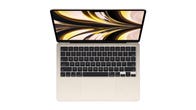
Read more: The 15 Best Laptops We Recommend for 2022
The post The M2 MacBook Air Is the Ultimate Laptop Gift first appeared on Joggingvideo.com.
]]>The post iPad 10th Gen Review: Better Design, Worse Price first appeared on Joggingvideo.com.
]]>
I wish life could be simple. Unfortunately, that’s not always the case. When it comes to Apple’s iPad lineup, which used to have just one model called the “iPad” back in the day, picking which one to buy has become a strangely entangled process.
Somewhere between every single model Apple offers is the perfect iPad, but it doesn’t currently exist in one single product.
That’s why I, as your reviewer guide, am having such a hard time with the review for Apple’s brand-new, redesigned 10th-gen iPad. Starting at $449 (£499, AU$749), it should be the iPad for everyone. But from what I’ve seen so far… it’s not. (This is a review in progress. As I use it more, I’ll weigh in with my final opinion.)
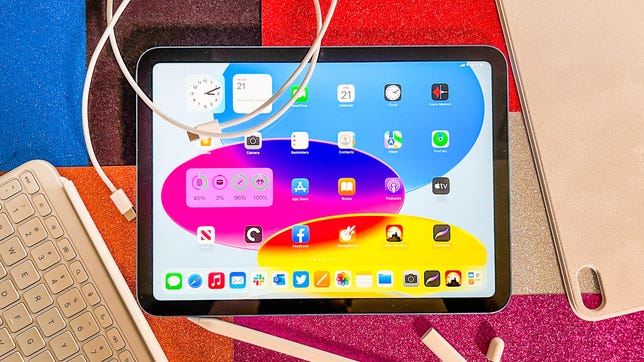
iPad (10th gen, 2022)
$449 at Amazon
Get Price Alerts
You’re receiving price alerts for iPad (10th gen, 2022)
Like
- Larger screen
- USB-C
- Faster A14 processor
- Front-facing camera’s in the right place
Don’t Like
- More expensive
- New design means fewer case options
- The 64GB entry-level storage isn’t enough
Maybe Apple already knows this, because the iPad lineup has six variants: 2022’s base model, last year’s ninth-gen iPad, the iPad Mini, the step-up iPad Air and the luxury iPad Pro, which comes in two sizes.
So which is the best one, you ask. “Stop talking about confusion, Scott, and help me.” This newly redesigned iPad nearly has it all: It has USB-C, finally! It has a bigger screen and better speakers, like the iPad Air. It’s the first iPad to move its camera to the horizontal edge for better FaceTime and Zoom calls.
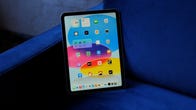

Now playing:
Watch this:
iPad 10th Gen and iPad Pro: Which iPad Should You Buy…
8:18
Then there are the downsides. If you want to use an Apple Pencil with this iPad, you have to use the first-gen one, which means using a weird USB-C dongle. It doesn’t work with iPad case accessories made for any other model, meaning you’ll have to buy new accessories. And the price has gone up. It’s $449 for the version with only 64GB of storage, but you’ll likely want the step-up model with more storage — 256GB for $599. And with any sort of case or AppleCare, you’re probably looking at well over $700. I haven’t even factored in a Pencil or Apple’s new $250 Magic Keyboard Folio Case.
In this economy, a better bet might be the ninth-gen iPad from 2021, which starts at $329, steps up to $479 for the higher storage tier and frequently can be found on sale. Apple took a similar approach to its latest MacBook Air: Increasing the price while adding features, but keeping the older model in the lineup.
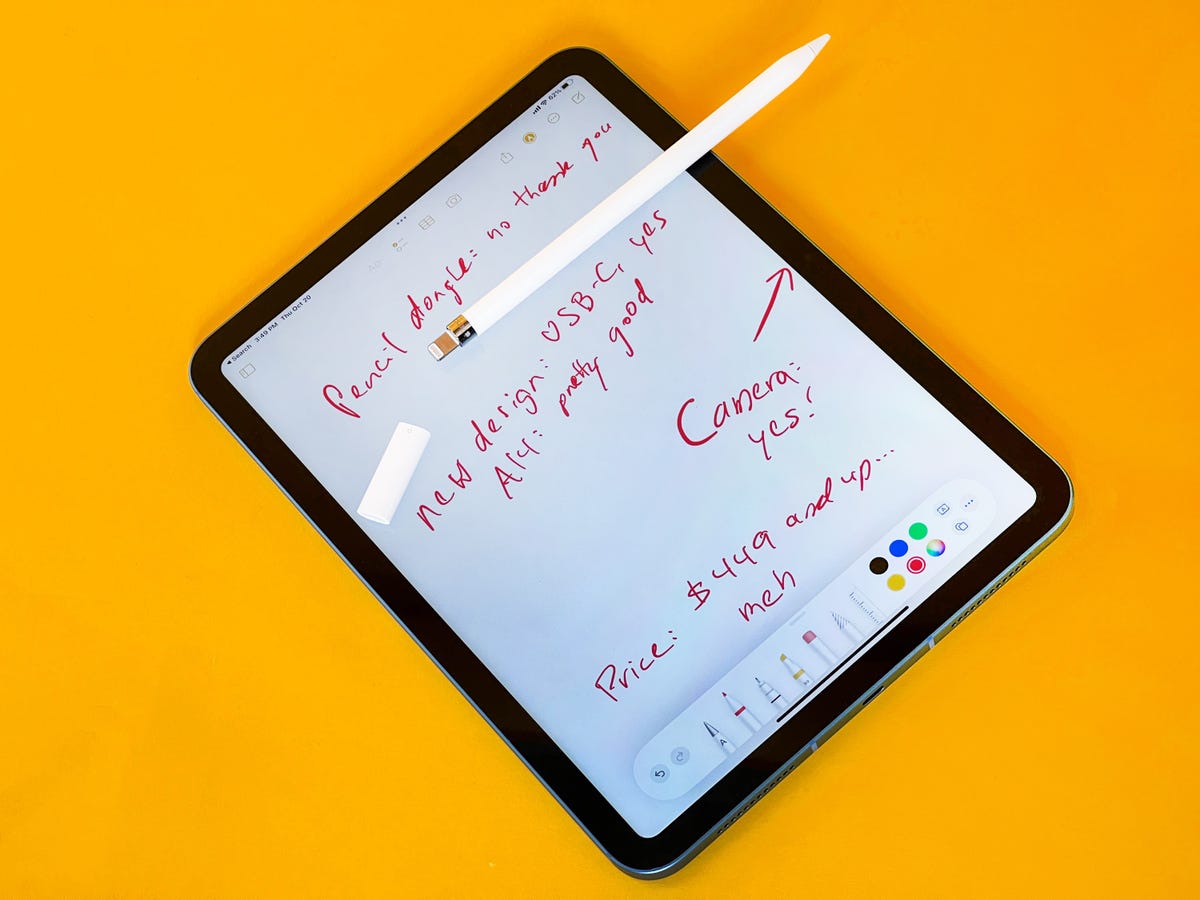

Scott Stein/CNET
And that’s a shame because this iPad, with its larger display, camera improvement and better processor, is the model I’d prefer — minus its weird Pencil accessory situation.
I don’t use the Apple Pencil much, despite how nice it is to draw with, so I might be OK with having to use the first-gen Pencil. But many other people won’t be. And it’s baffling, frankly, why Apple decided to not make this iPad compatible with the more useful Pencil 2 despite all of its other improvements. (You can even get 5G through the modem-enabled version.)
I’m going to unplug my Pencil 1 from its dongle now and rest it somewhere where it won’t roll off the table while I continue this iPad review.
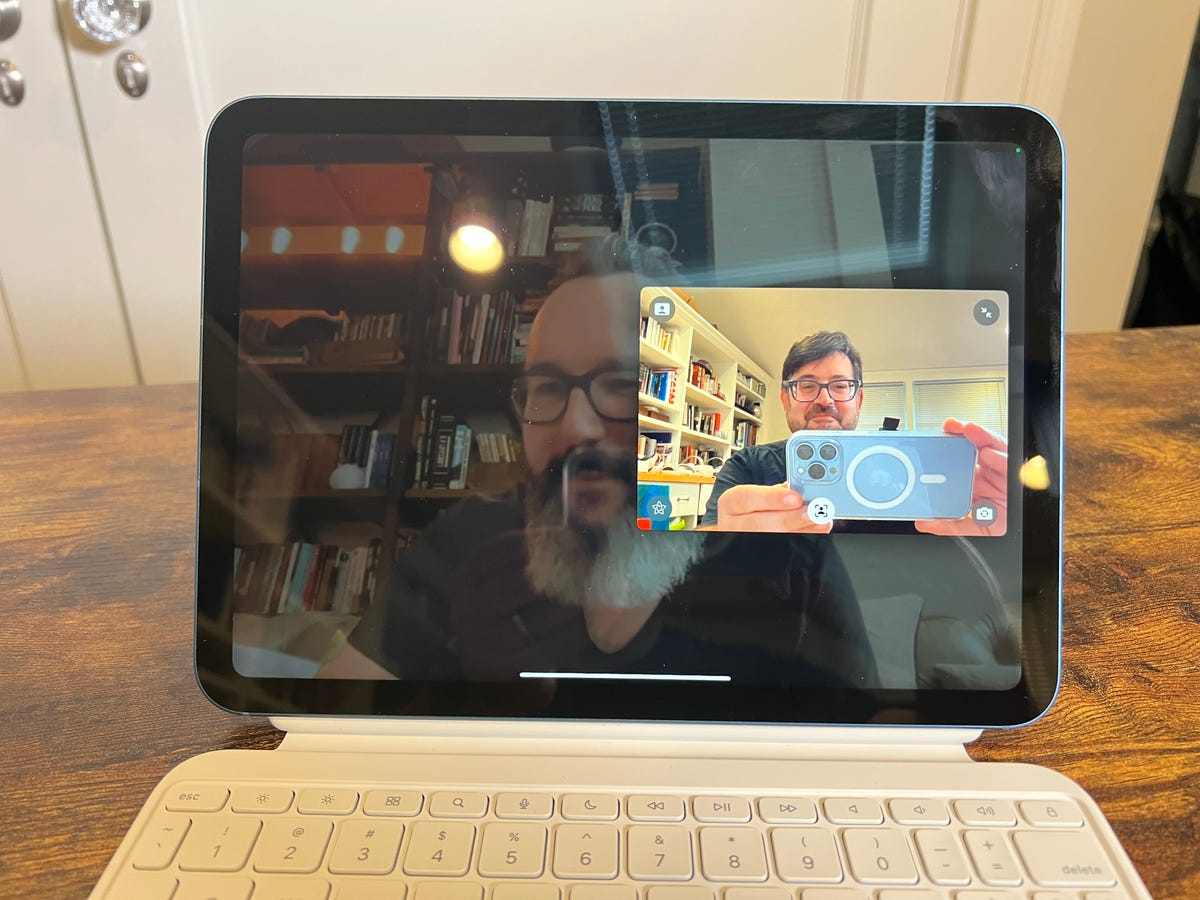

Me, celebrating that the camera finally looks great on a call with CNET’s Dan Ackerman.
Scott Stein/CNET
Camera: Yes, finally, it’s perfect
The one big thing I wanted from the iPad arrived, like a magic wish granted: The weirdly placed front camera on the iPad is now on the landscape edge. This is great. Why is this great? Because I work on iPads in landscape mode, in cases and stands and keyboard docks. When I Zoom or FaceTime on other iPads, my face looks weirdly off-angle with my eyes looking elsewhere. That’s fixed now. Combined with the auto-zooming Center Stage tech, this iPad’s video chat camera is absolutely perfect.
This, alone, makes me want to use this iPad more than any other. But, alas, Apple’s only moved the camera’s position for this iPad. No other model, not even the new iPad Pros, have it. Why? I have no idea. This is clearly the future of camera placement, so you’re one step ahead if you buy this model.
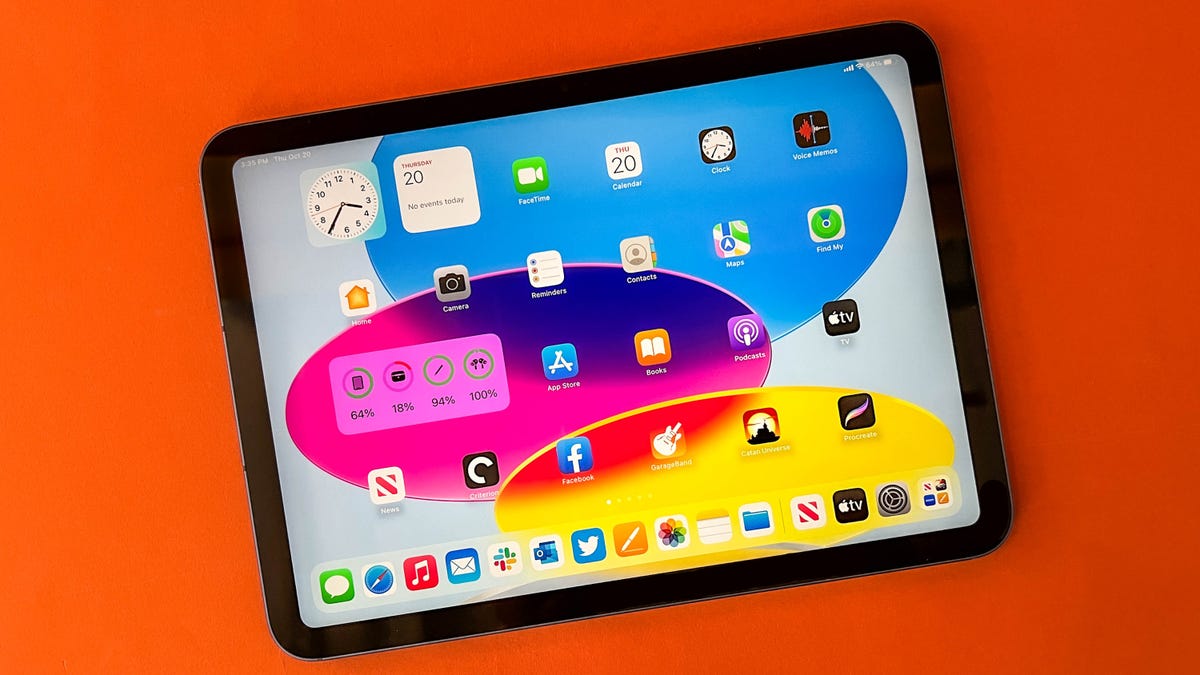

This iPad adopts the look of the iPad Air and iPad Pro. It’s mostly great.
Scott Stein/CNET
Design: Mostly better, but not always
This iPad has adopted the design style of all other iPads at last, with USB-C charging replacing Lightning and a flat-edged case with a larger, curved-corner 10.9-inch display. This iPad has better speakers than the ninth-gen model, and the display feels notably bigger. The display lacks the anti-reflective coating and extra color gamut of the iPad Air.
It doesn’t have the smooth-scrolling 120Hz ProMotion on the iPad Pro models, but it’s more than good enough for basically anything. Often, I had a hard time telling the difference between the iPad Air and this iPad in everyday use.
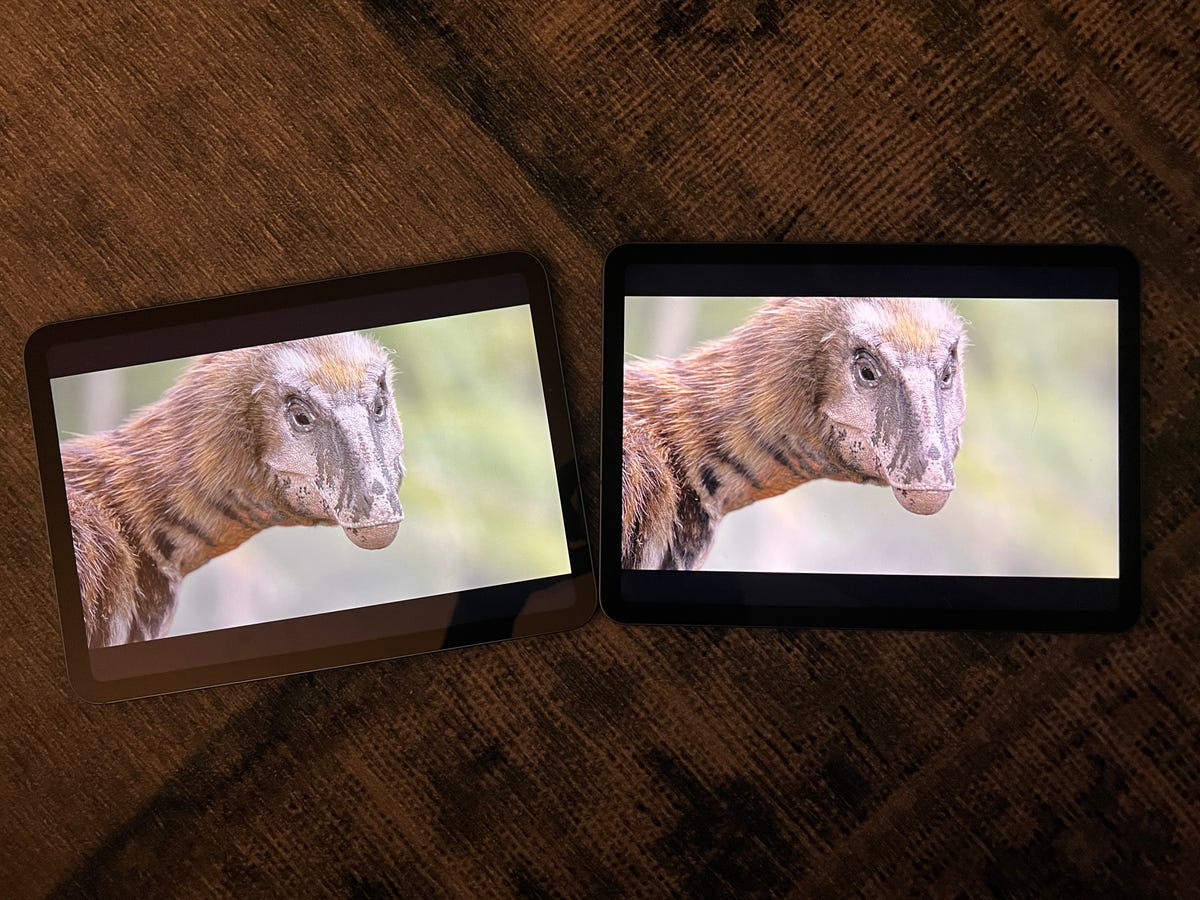

The 10th-gen iPad (left) next to the iPad Air (right), watching Prehistoric Planet. My family had a hard time telling the difference.
Scott Stein/CNET
This iPad is, effectively, the 2020 iPad Air minus a few features. The Air had the same A14 processor, but also supported the Pencil 2. It also had a rear Smart Connector that supported the Magic Keyboard case.
There’s no home button anymore, with Touch ID moving to the small side-placed power button, which the iPad Mini and iPad Air also have. I love this and wish the iPhones had it, too. There’s no Face ID camera, which is fine, because I wear a mask a lot anyway and Touch ID has been more convenient lately.
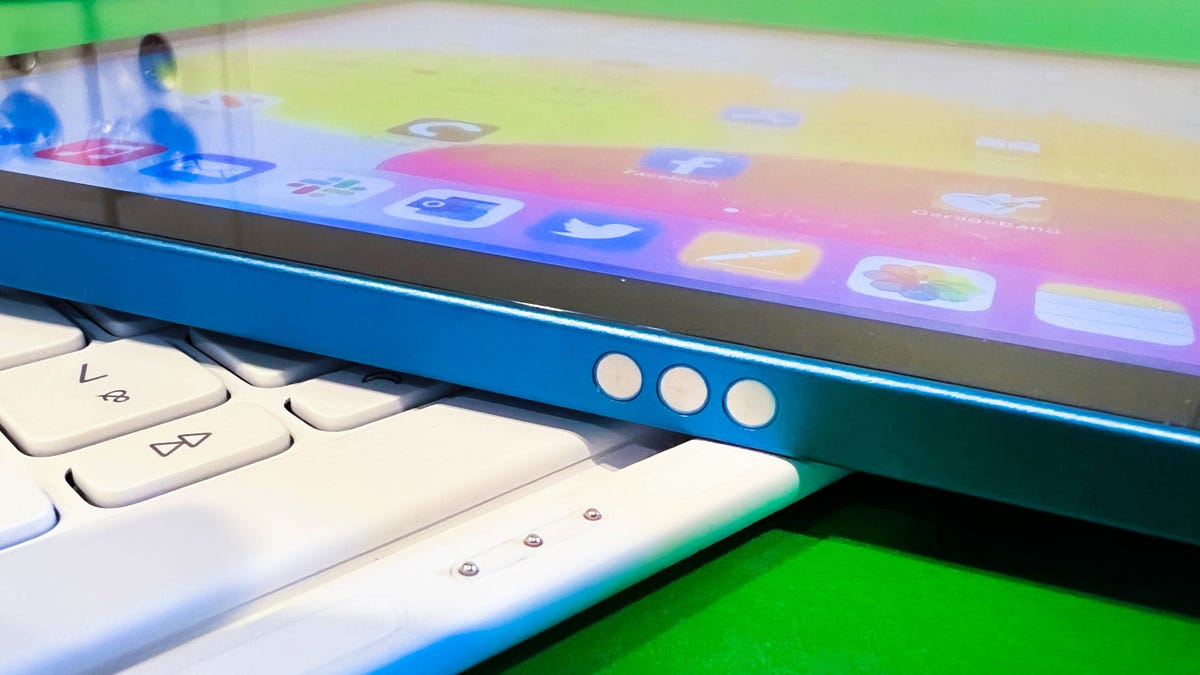

The new location of the Smart Connector: on the side.
Scott Stein/CNET
The downside to the design is it’s a bit thicker than the current 11-inch iPad Pro and iPad Air, meaning this won’t work with any of those cases. This means shopping for all-new accessories. Apple also created a differently placed Smart Connector on the side edge, which works with Apple’s iPad-made Keyboard Folio Case. More on that below.
I asked my 14-year-old son, who uses an iPad all the time, what he thought of it. He said, “I don’t care, it looks the same.”
But there’s one thing about this iPad’s design I can’t stand.
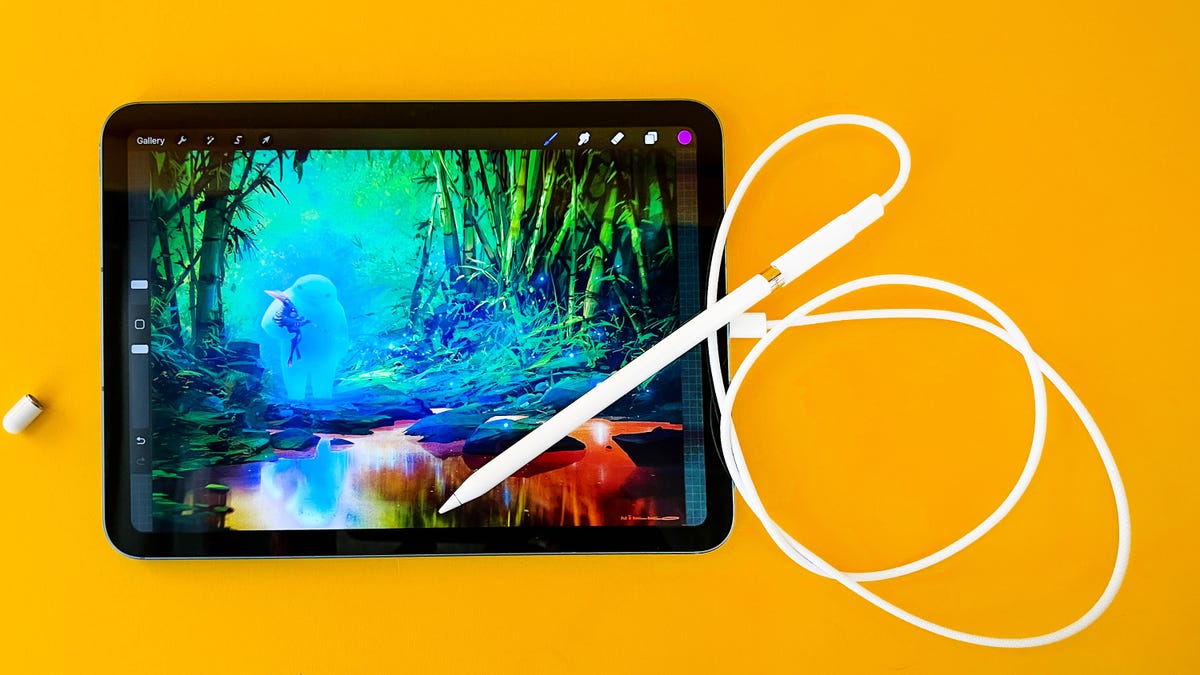

This is how you attach the Pencil now.
Scott Stein/CNET
Pencil: Really?
The best thing I can say about this iPad is it works with the Apple Pencil, but I think that’s almost on a technicality. Apple skipped support for the magnetically charging snap-on Pencil 2 with this model, so you’ll need to use the Pencil 1 — which rolls a lot, has an easy-to-lose end cap, doesn’t have extra side-tap controls and charges via Lightning.
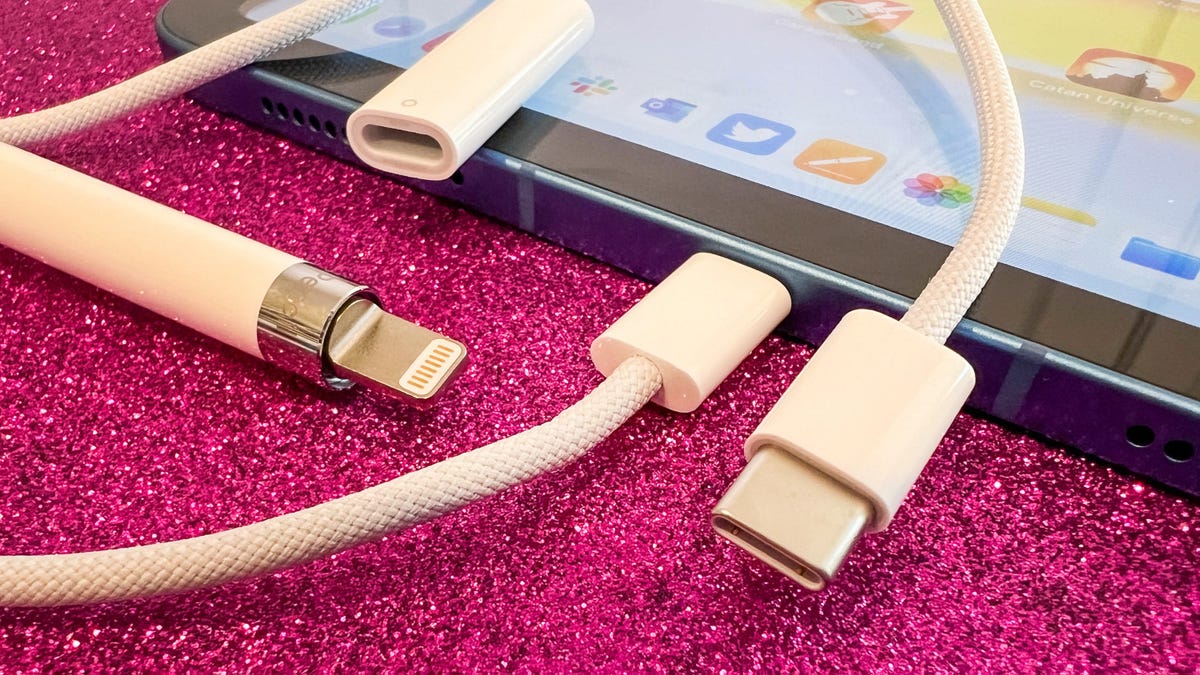

It’s a lot of connectors. Also, that Pencil-to-USB dongle is not included in the iPad box.
Scott Stein/CNET
Except instead of plugging the Pencil into the side of the iPad to charge, you’ll need a separate USB-C dongle and the charge cable to charge it. Not only is that weird, it’s frustrating. The odds I’ll bring all that stuff with me when I need it are slim. If you’re serious about making art on an iPad using the Apple Pencil, this bizarre move is bad enough to skip this model entirely. (Even the iPad Mini works with the Pencil 2, come on.)
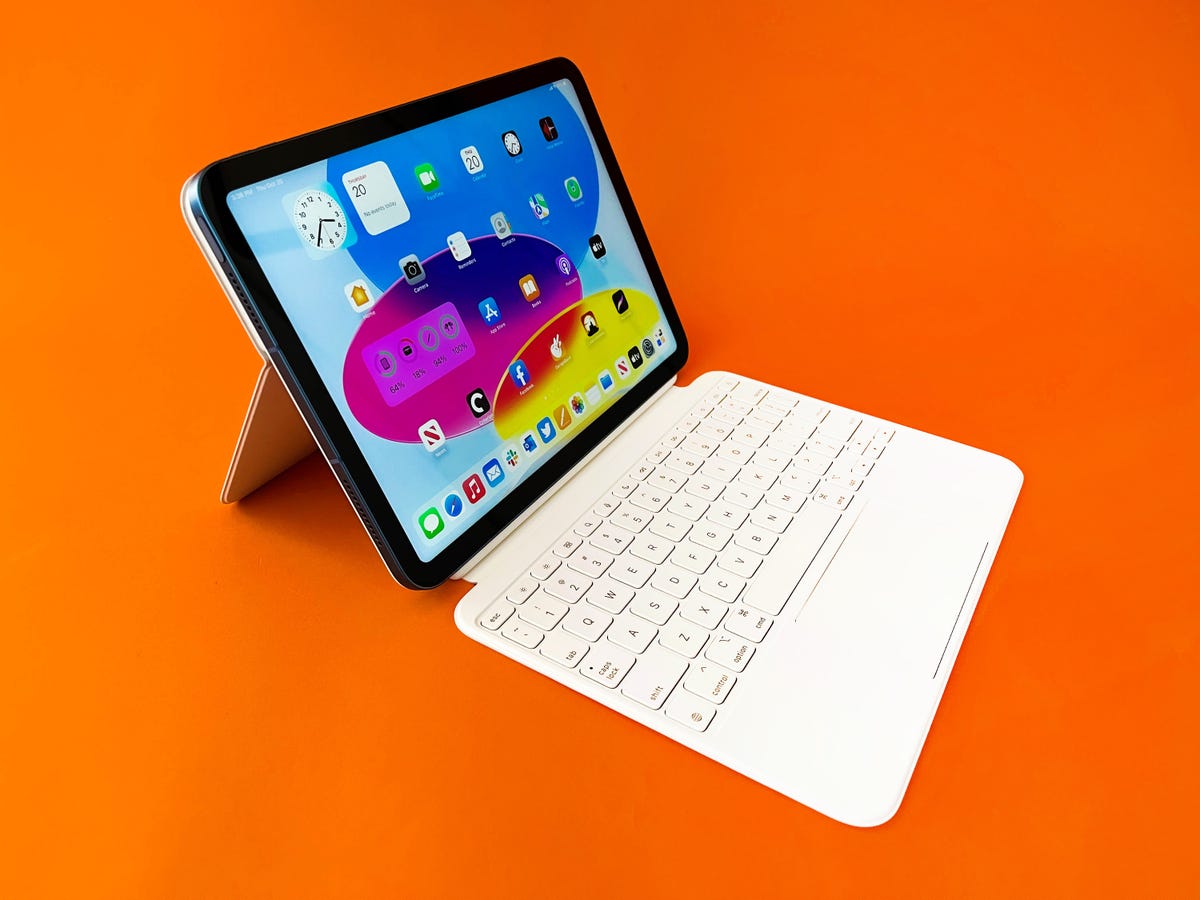

Apple’s new Magic Keyboard Folio has a look similar to previous Logitech cases.
Scott Stein/CNET
Magic Keyboard folio case: An imperfect solution
Apple redesigned its keyboard-connected case yet again for this new iPad, taking an approach that feels a lot different than its Magic Keyboard case. That case, which works with the iPad Air and Pro, is expensive ($300 and up), heavy, can’t be used as an everyday case because of its inflexible angles, but is excellent for working on small work surfaces or laps.
The folio case is still expensive at $250. It’s split into two parts (a keyboard that snaps on the side and a kickstand back cover that snaps to the iPad back), can be used as an everyday case and adds a helpful row of function keys on the top. But it isn’t lap-friendly and lacks keyboard backlighting. I wrote this whole review on it, but I edited and posted it on a MacBook Air.
I’ve used keyboard cases by Logitech and others, and the Surface Pro has a similar keyboard design. You can get Logitech’s cases for less, and they offer better protection: Apple’s case doesn’t protect the iPad’s sides at all, and it looks ready to pop off if you ever drop the iPad. The keys feel a little different to me than the other Magic Keyboards or my MacBook Air. I don’t like it quite as much.
Also, there’s no place to put the Apple Pencil. Which, last I checked, was rolling around somewhere.
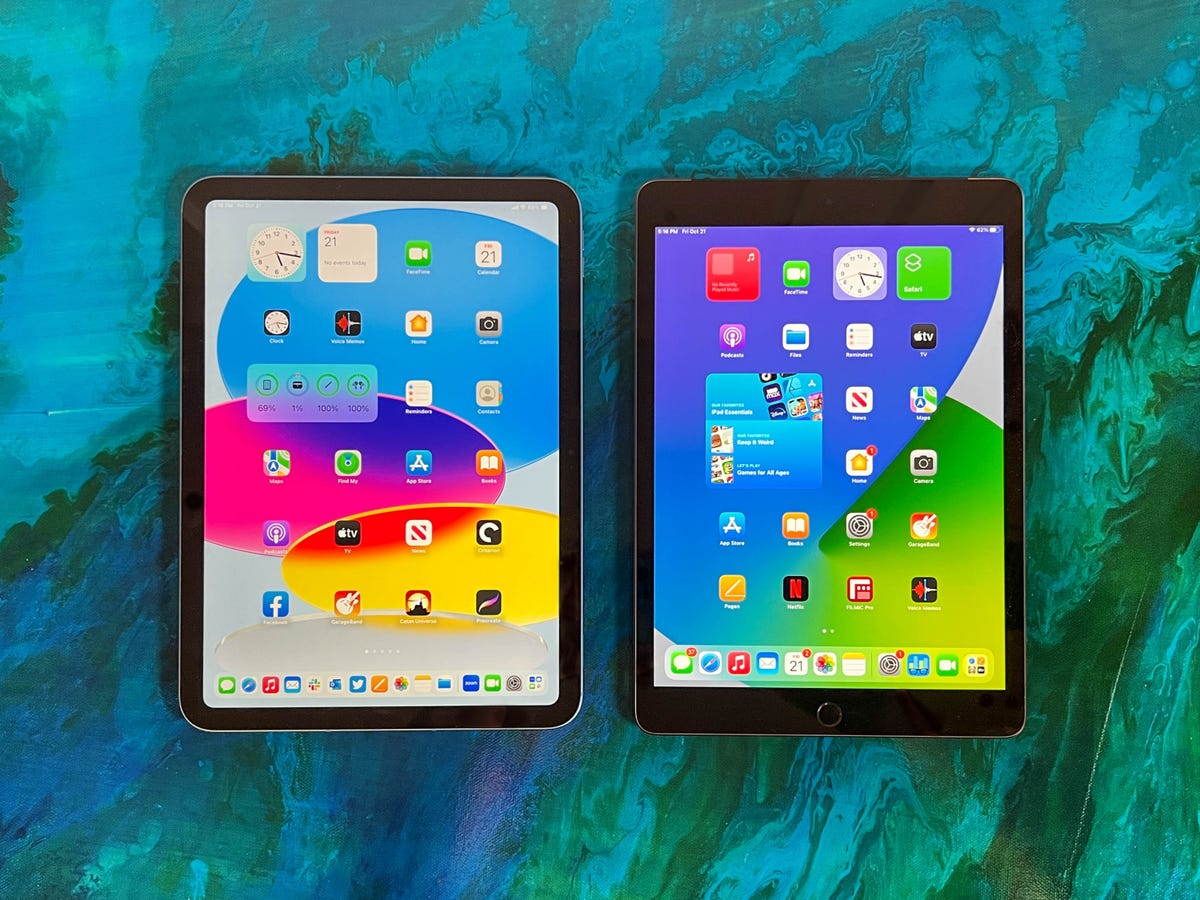

The iPad 10th Gen (left) next to the iPad 9th Gen (right). The new iPad has a better A14 processor: not as fast as M1, but good enough. (The ninth-gen iPad is still fine too, though).
Scott Stein/CNET
Performance: More than good enough
The A14 processor has been around for a while (it was on the iPhone 12). Here it comes with 4GB of RAM, similar to the iPhone 12 and 2020 iPad Air. The results are good: More than fast, but it’s not as blazing as the M1 in the Air or the M2 in the new Pro.
Do you need bleeding-edge iPad performance? I don’t think so. The gains over last year’s ninth-gen iPad are significant, but no different than the iPad Air model from 2020. Apple’s mobile processors are now so powerful that the iPad software needs to catch up to their potential.
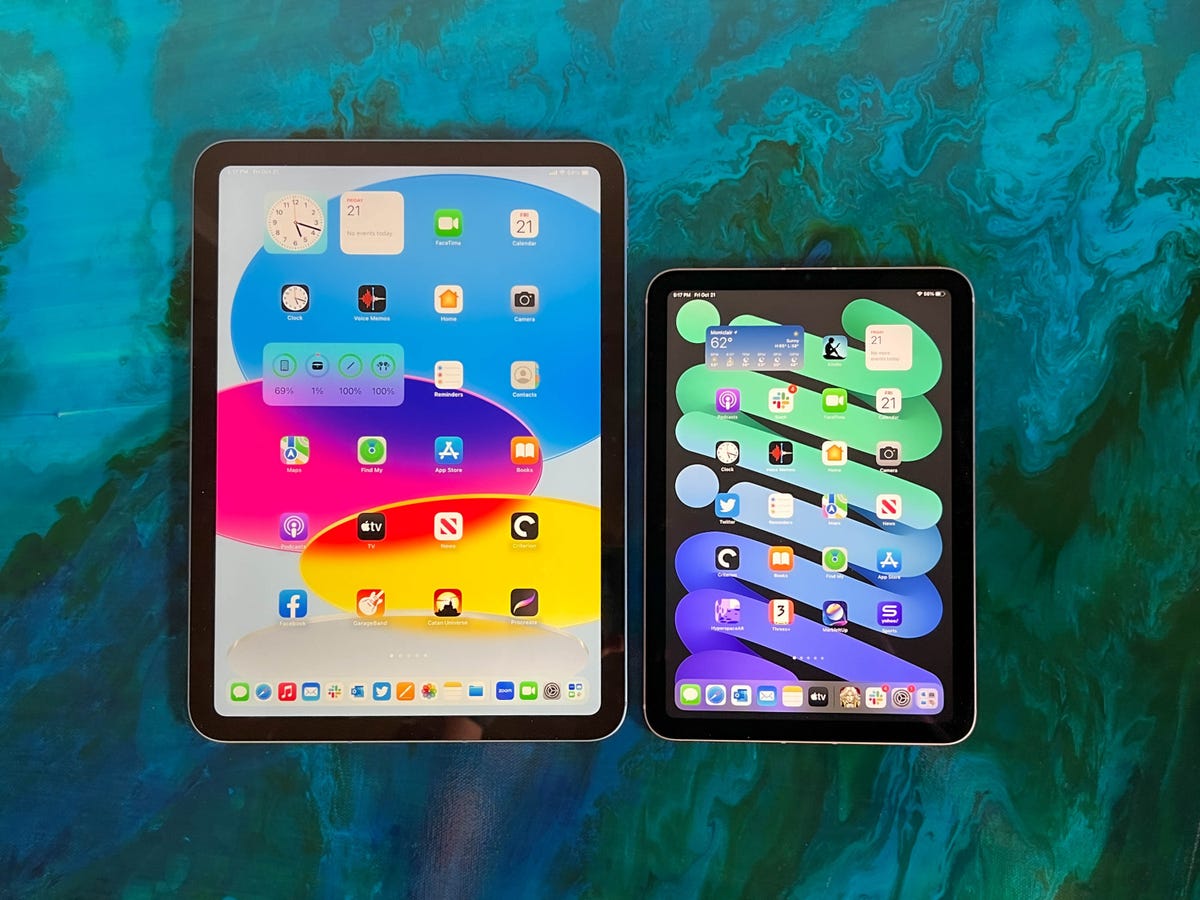

The iPad next to the iPad Mini. The family feels complete. but not all the features have come together.
Scott Stein/CNET
Should you wait? Maybe
Apple’s iPad lineup has been staggered lately: Base and Pro models arrive in the fall (sometimes) and the Air model comes in the spring (sometimes). Last spring’s iPad Air has slight improvements over this iPad, with an M1 chip, subtly better display and Pencil 2 support. But it doesn’t have this newly fixed front camera. The same thing happened last year when the entry-level iPad added Center Stage zoom while the iPad Air was left without it.
The iPad Air costs $150 more and could be tempting. Apple keeps its upgrade increments just within reach, like sizes of popcorn at a movie theater. Suddenly, you’ll find yourself entering iPad Pro land, and a thousand dollar-plus package. Pull back and ask yourself: Will this model go on sale? Would you be happy with last year’s iPad instead? Would you rather see if something better for the Air comes next spring?
The only thing that concerns me for future upgrades is that Apple’s leaning on its M1 chips as the cutoff for more advanced software features, although right now that mostly just means better external monitor support with Stage Manager, a feature that’s currently so buggy Apple’s delayed the release to later this year. I’d say you’re fine without the M1, especially since the A14 is more than good enough.
Down the road, having an old Pencil and a sub-M1 chip could leave this iPad on the other side of the future. Then again, you’ll be saving money. Apple hasn’t made this iPad lineup easy this year. It feels like the iPad is a product still in transformation. Right now, its perfect form doesn’t exist.
The post iPad 10th Gen Review: Better Design, Worse Price first appeared on Joggingvideo.com.
]]>The post Pixel 6A Deal Brings Record Low Price of $299 For Limited Time first appeared on Joggingvideo.com.
]]>
The new flagship Pixel 7 series hit shelves earlier this month, the Pixel 6A will remain the budget option for those looking for a great Google Pixel deal. And right now, you can pick up an unlocked model for the record-low price of $299, which knocks $150 off the usual price. However, there’s no clear-cut expiration on this offer, and deals this good rarely last for long. We’d recommend getting your order in sooner rather than later if you want to take advantage of these savings.
See at Amazon
Sporting a 6.1-inch OLED display, Titan M2 chip, Google Tensor processor, Google’s Android operating system, 6GB of RAM and 128GB of storage, this budget phone certainly delivers a lot of bang for the buck. That’s why we’ve named it the best Android phone under $500 on the market right now.
The 12.2-megapixel camera may be a step down from the camera on the Pixel 6. But it’s still a great camera for the price, and it comes equipped with tools including the Magic Eraser, Motion Mode and Portrait Mode.
This phone can last over 24 hours on a single charge, depending on how you use it. The battery is adaptive and learns which apps you use the most, which can save you power by not wasting your battery life on the ones you rarely use. This phone is IP67-rated water- and dust-resistant, so your phone should be safe in most environments and conditions.
Another great feature this phone offers is Live Translate, which will help you translate signs, live video captions and private chats and messages in up to 55 languages. At $299, this is a solid phone worth checking out.
Get your next phone for the best price.
Set price alerts on your favorite models with the CNET Shopping extension and get notified when prices drop.
The post Pixel 6A Deal Brings Record Low Price of $299 For Limited Time first appeared on Joggingvideo.com.
]]>The post Pixel 7 Pro vs. iPhone 14 Pro: Which Phone Camera Is Better? first appeared on Joggingvideo.com.
]]>This story is part of Focal Point iPhone 2022, CNET’s collection of news, tips and advice around Apple’s most popular product.
Google’s Pixel 7 Pro has an excellent triple-camera setup that’s already seriously impressed me, alongside the phone’s slick new design and streamlined Android 13 software. But the competition is fierce, with Apple’s latest iPhone 14 Pro also packing some potent specs and a set of cameras that can take truly superb images.
So which one does it best and which one should you consider if you’re looking for the best photography phone around? I took both phones around the stunning Edinburgh suburb of Leith to find out.
It’s an interesting matchup as both phones have similar camera offerings with a main standard lens, an ultrawide lens and a telephoto zoom. And both have already proven their photographic prowess in our full reviews, with rich images and excellent dynamic range being delivered on both sides.


Pixel 7 Pro, main lens.
Andrew Lanxon/CNET


iPhone 14 Pro, main lens.
Andrew Lanxon/CNET
Take a look at the photos above from the Pixel 7 Pro’s 50-megapixel and the iPhone 14 Pro’s 48-megapixel main camera lens. Both scenes are well exposed here, with controlled blue skies and plenty of detail to be seen in the more shadowy areas. The iPhone’s color balance is a bit warmer, which I think suits the scene well, although the Pixel’s image is arguably a touch more natural looking.


Pixel 7 Pro, ultrawide lens.
Andrew Lanxon/CNET


iPhone 14 Pro, ultrawide lens.
Andrew Lanxon/CNET
Switch to the ultrawide lens, and again both phones have done a great job in capturing this high contrast scene above. There’s very little to choose between them, but I think the Pixel 7 Pro’s more natural color tones might give it the edge.


Pixel 7 Pro, 5x optical zoom lens.
Andrew Lanxon/CNET


iPhone 14 Pro, 3x optical zoom lens.
Andrew Lanxon/CNET
Things change when we switch to the zoom lenses though, most notably because the Pixel 7 Pro’s 5x offers a much closer view than the 3x optical zoom of the iPhone 14 Pro. I love a longer zoom as it helps you find different photo compositions in a scene that would be lost to those who only have wide angle lenses. Using the zoom lens for the photos above let me capture a totally different scene, but I didn’t have to physically move to get it.
That extra reach is noticeable on the Pixel’s shot, with a much closer zoom on the buildings in the distance. Both phones have achieved a good exposure however, and while the Pixel’s image is noticeably warmer (particularly on the buildings themselves), I like the color balances of both shots.


Pixel 7 Pro, 5x zoom lens.
Andrew Lanxon/CNET


iPhone 14 Pro, 3x zoom lens.
Andrew Lanxon/CNET
Again, that extra zoom on the Pixel let me get a tighter composition on the buildings next to the river in the images above, and it’s a better-looking photo as a result. That said, I prefer the tones and exposure of the iPhone’s shot, with brighter whites and a more vibrant pop of orange visible on the central building and richer blue tones in the sky.


Pixel 7 Pro, ultrawide lens.
Andrew Lanxon/CNET
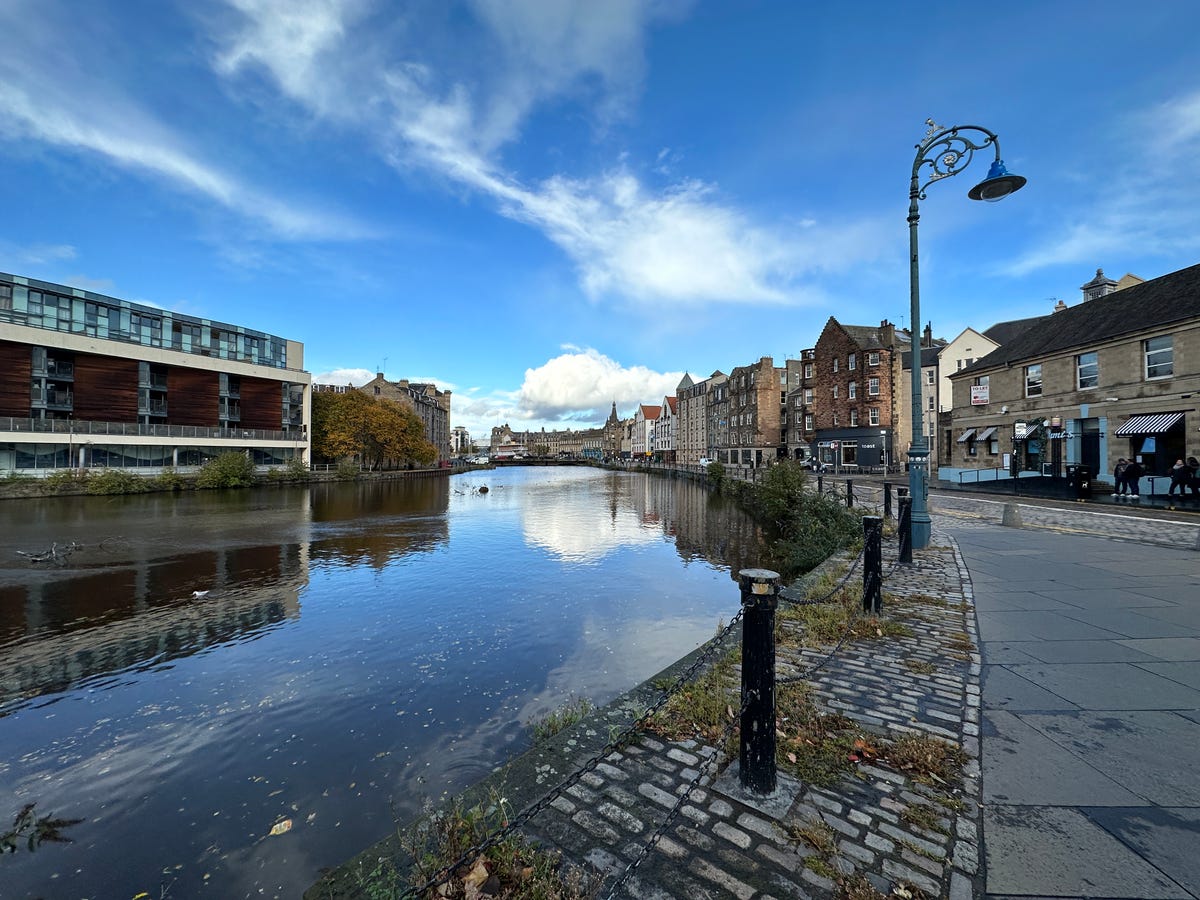

iPhone 14 Pro, ultrawide lens.
Andrew Lanxon/CNET
The ultrawide photos above are more mixed however. While both phones achieved a generally decent exposure, they both have slightly blown out highlights visible in the distant clouds. And while I prefer the more natural blue sky of the iPhone 14 Pro, the Pixel 7 Pro has achieved more vibrant color tones on the buildings and trees toward the center of the frame. It’s tough to make a call on which is “better” here.


Pixel 7 Pro, main lens.
Andrew Lanxon/CNET


iPhone 14 Pro, main lens.
Andrew Lanxon/CNET
Back to the main camera lens, and there’s again very little to choose between the two pictures above. There’s tons of detail in both, and the overall exposure is spot on. If I were nitpicking — which I am — I’d say the Pixel 7 Pro’s sky has a bit too much of a purple tinge in it and it’s a slightly more contrasty scene overall. While that’s resulted in deeper orange hues on the fall leaves, it’s less representative of the actual colors of the scene. It’s largely down to personal preference, but I’m marginally erring toward the iPhone’s shot here.


Pixel 7 Pro, ultrawide lens.
Andrew Lanxon/CNET


iPhone 14 Pro, ultrawide lens.
Andrew Lanxon/CNET
The photos above show the same scene but from the ultrawide lens this time. To my eye, it’s an easier win for the iPhone here. The overall color balance is more natural. And while the iPhone kept a decent contrast in the darker area in the bottom left, the Pixel has tried to brighten this area artificially, resulting in a weird-looking grey patch that I’m not keen on.


Pixel 7 Pro, wide-angle lens with macro focus.
Andrew Lanxon/CNET


iPhone 14 Pro, wide-angle lens with macro focus.
Andrew Lanxon/CNET
With the Pixel 7 Pro now packing auto-focus on its ultrawide lens, it’s able to offer macro photography as it can focus within a couple of inches of the lens. It’s something Apple introduced on the iPhone 13 Pro, and it’s great fun to experiment with.
In the macro photos above, I prefer the image from the Pixel 7 Pro’s camera. The white balance has resulted in more vibrant — and more accurate — blue-purple tones on the flower’s petals. The leaves in the background also have more of an emerald tone, rather than the yellow-green tones seen on the iPhone’s shot.
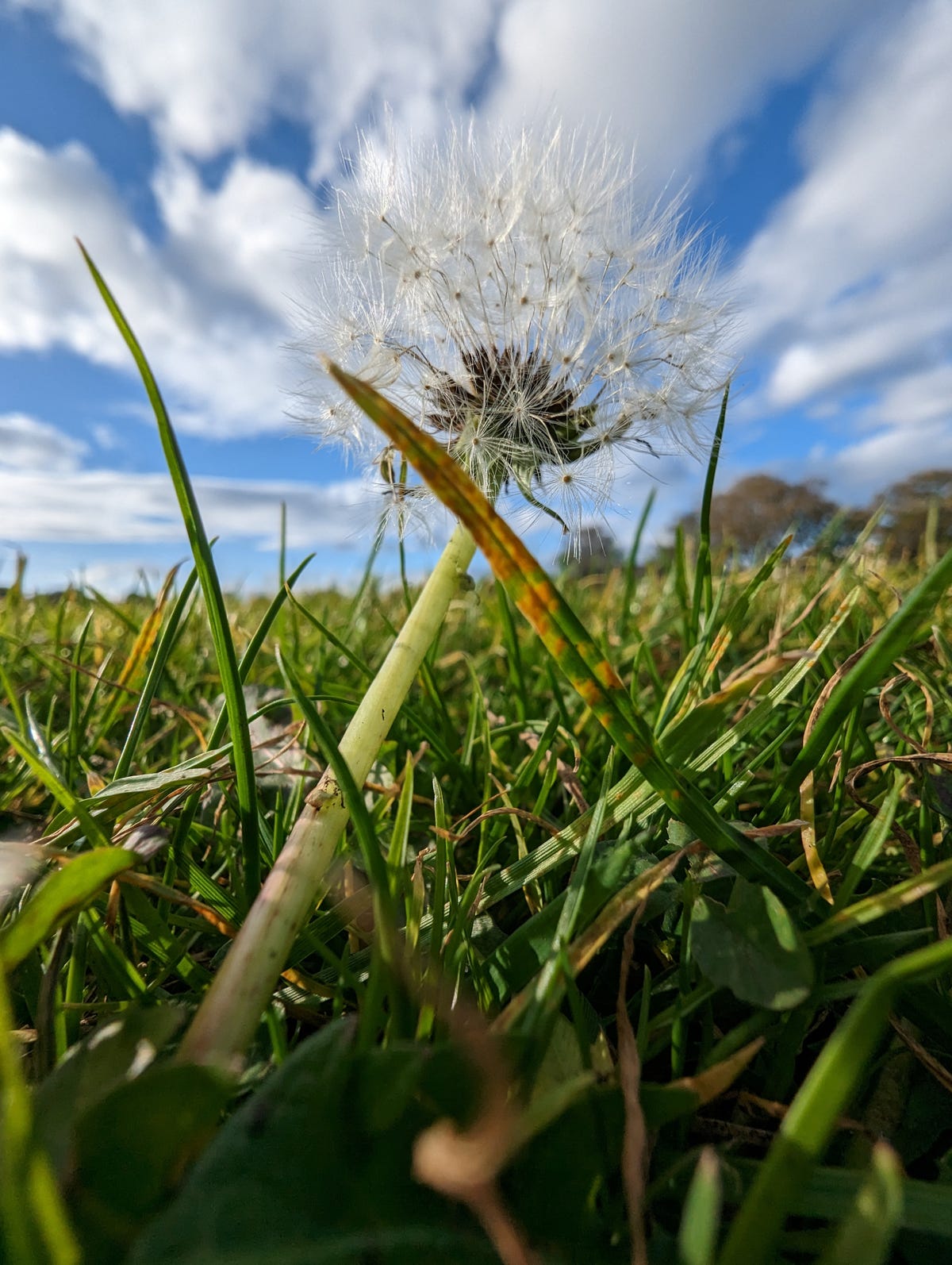

Pixel 7 Pro, wide-angle lens with macro focus.
Andrew Lanxon/CNET
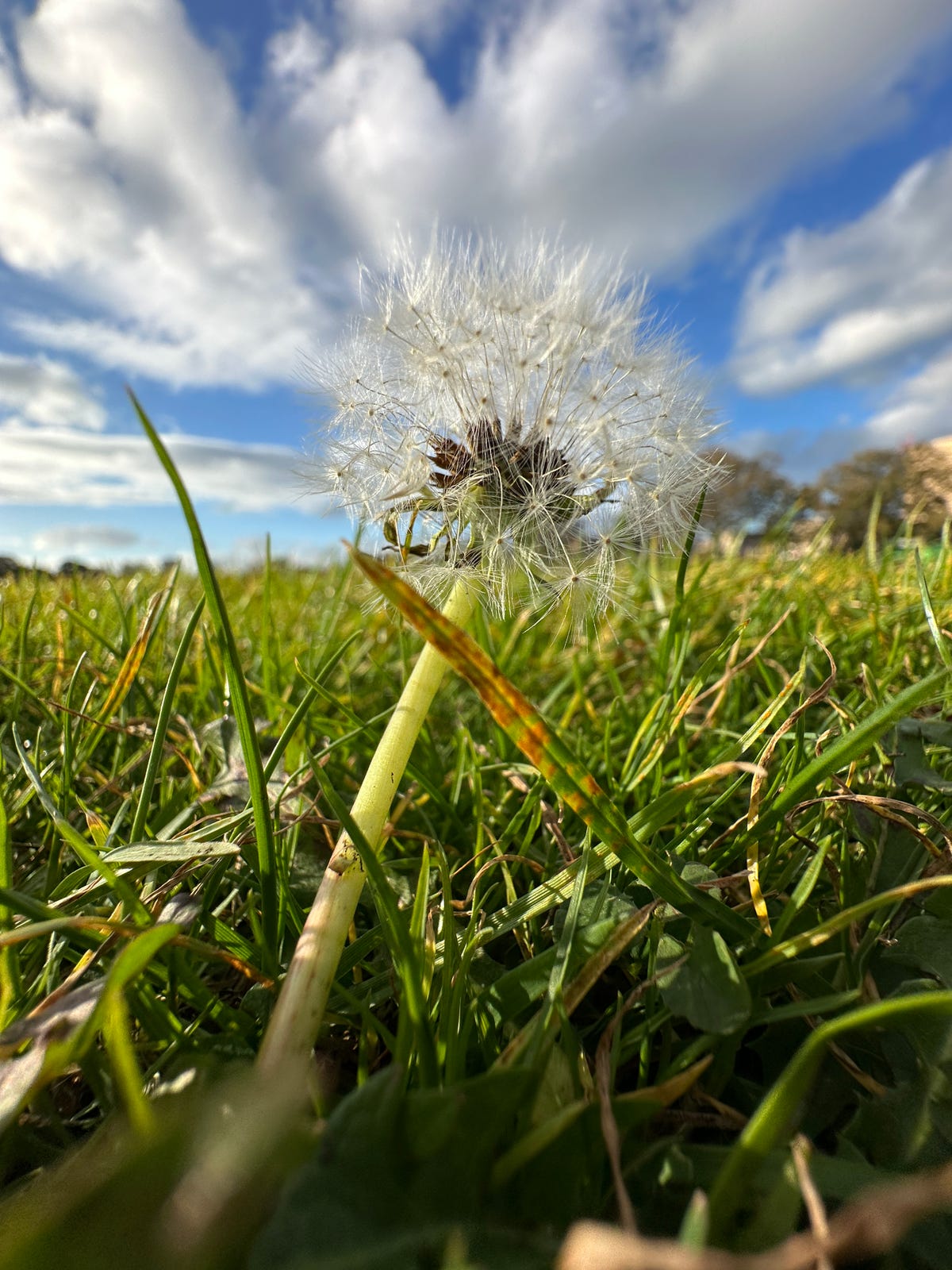

iPhone 14 Pro, wide-angle lens with macro focus.
Andrew Lanxon/CNET
And it’s much the same in the pictures above when I used the phones to get a low-down shot of this dandelion, with the blue sky behind it. The Pixel 7 Pro’s shot has much more vibrant green tones in the grasses around the subject. The iPhone 14 Pro captured a warmer scene, with more yellow tones seen in the grasses that I personally don’t like as much.


Pixel 7 Pro selfie camera test.
Andrew Lanxon/CNET


iPhone 14 Pro selfie camera test.
Andrew Lanxon/CNET
The Pixel 7 Pro is packing a 10.8-megapixel front-facing selfie camera, which is slightly below the iPhone 14 Pro’s 12 megapixels. It’s not a huge difference, there is slightly more detail visible when you zoom in. Both shots are generally solid, however, although I think the Pixel has gone a bit too “HDR” by reducing the highlights on my face too much. Personally, I prefer how I look in the iPhone’s image.


Pixel 7 Pro wide-angle selfie test.
Andrew Lanxon/CNET


iPhone 14 Pro wide-angle selfie test.
Both phones have a wider-angle option for the front-facing cameras, which is helpful if you want to capture more of your surroundings or want to squash more of your friends into the picture. I took the photos above in this mode, and the Pixel actually has the edge slightly in terms of fine image details. But again, I prefer the exposure and contrast from the iPhone as the Pixel’s HDR has flattened the tones in my face a bit too much for my liking.


Pixel 7 Pro, night mode.
Andrew Lanxon/CNET


iPhone 14 Pro, night mode.
Andrew Lanxon/CNET
When switching to night mode on both phones, I had to give an early win to the iPhone in the photos above. Its white balance produced a nicer-looking shot without the overly warm orange tone seen in the Pixel’s image.


Pixel 7 Pro night mode, 100% crop.
Andrew Lanxon/CNET


iPhone 14 Pro, night mode, 100% crop.
Andrew Lanxon/CNET
It’s also clear that the iPhone’s image is sharper when cropping in to 100% on both images, with the Pixel’s shot showing some motion blur, particularly on the pub sign. Look at the spotlights on the wall sculptures above; the Pixel’s shot hasn’t been able to capture the dynamic range here, resulting in blow-out areas, while the iPhone has done a much better job of keeping those bright tones under control.


Pixel 7 Pro, night mode.
Andrew Lanxon/CNET


iPhone 14 Pro, night mode.
Andrew Lanxon/CNET
There’s not as much to choose between in these night-time shots above that I took overlooking Leith Shore. Both have similar color tones, exposure and only marginal improvements on the iPhone’s shot when viewed at 100%.


Pixel 7 Pro night mode, 5x zoom.
Andrew Lanxon/CNET


iPhone 14 Pro, night mode, 3x zoom.
Andrew Lanxon/CNET
Switch to the zoom mode, and there’s a bigger difference between the two phones. In the images above, the Pixel’s shot is brighter and more vibrant but suffers hugely from motion blur, despite that fact that I stabilized myself against a bridge wall when taking the shot. I took three images here and this was the best I could get.


Pixel 7 Pro, night mode, 5x zoom at 100% crop.
Andrew Lanxon/CNET


iPhone 14 Pro, night mode, 3x zoom at 100% crop.
Andrew Lanxon/CNET
You can really see how blurry the Pixel’s image is when cropping in to 100%. Sure, the iPhone doesn’t have the same reach with its 3x zoom. But its shot is much sharper and clearer, and it easily takes the win here.


Pixel 7 Pro, night mode.
Andrew Lanxon/CNET


iPhone 14 Pro, night mode.
Andrew Lanxon/CNET
I also found that the Pixel 7 Pro is particularly susceptible to lens flare at night when shooting towards bright light sources like the street lamp shown in the pictures above. While both cameras suffer from lens flare, the Pixel’s is particularly problematic since most of the night sky is filled with red-pink flares surrounding the light. It’s a shame because this would otherwise have been a nice night-time scene.
Which phone takes better pictures?
Both phones took some truly superb photos during this test, and it’s not easy to give either one the definitive win. Some elements of what makes a “better” photo will come down to personal preference. In well-lit outdoor shots, I found that the Pixel 7 Pro achieved a more natural color tone from its main lens than the iPhone managed. But its colors weren’t as good in some wider-angle shots. Of course, you can set up different photographic styles on the iPhone to customize how the camera captures photos and make them look more natural if that’s your preference.
At night the iPhone is the clear winner though, with better colors, crisper detail and a superior ability to handle bright light sources — both in terms of exposure and lens flare. However, the Pixel 7 Pro absolutely takes the win with its superior zoom skills, with its 5x zoom letting you snag beautiful, crystal-clear images that are simply out of reach of the iPhone’s 3x zoom. I also preferred the look of the Pixel’s macro images in all of the tests I shot.
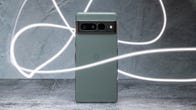

Now playing:
Watch this:
Pixel 7 Pro Review: Google’s Best Phone Gets Better
10:14
So which is “best” will come down to what you want most from your phone camera. If night photography is important, then go for the iPhone 14 Pro. If you want zoom skills to find creative compositions in your landscapes and street photography, then the Pixel 7 Pro is for you.
If you just want a great all around camera to snap vibrant shots of your kids at the beach, your friend’s food at a local market or some stunning woodland scenes on your next hike, then either phone will suit you incredibly well. Your bigger decision will instead come down to whether you want to go with iOS or Android as your operating system and whether spending the extra hundred bucks or so on the iPhone 14 Pro is worth it.
Pixel 7 Pro: Subtle Tweaks Improve Google’s Best Phone
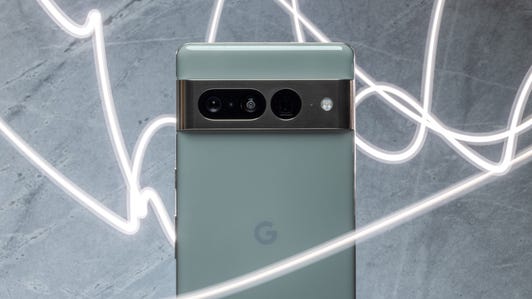

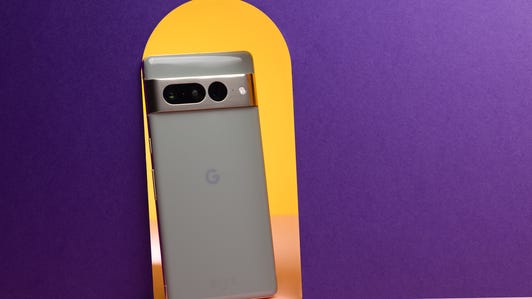

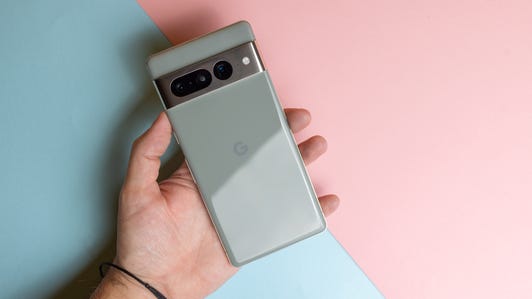

+16 more
The post Pixel 7 Pro vs. iPhone 14 Pro: Which Phone Camera Is Better? first appeared on Joggingvideo.com.
]]>The post 6 Places Every Home Should Have Security Cameras first appeared on Joggingvideo.com.
]]>This story is part of Home Tips, CNET’s collection of practical advice for getting the most out of your home, inside and out.
Not every home is the same, but everyone’s property deserves to be protected. Security cameras are a great tool to achieve a sense of security, as they give you extra eyes on your property at all times.
Your property’s layout, budget and home security priorities are different from your neighbor’s, so there is no one-size-fits-all rule for security camera placement. But this guide will help you consider all the aspects of your home security setup and identify which ones are absolute musts based on the vulnerabilities in your home.
For more home security tips, check out how to prevent your home security cameras from being hacked, and the best cheap home security systems you can buy.
Best Home Security Cameras of 2022
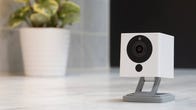
Where you should consider installing a camera
1. Exterior: Front door
You might assume that intruders always sneak into side entrances, but statistics from the International Association of Certified Home Inspectors show that 34% of burglars use the front door. It’s also where package thieves are likely to strike. A camera at your main entrance keeps tabs on everybody going in and out of your home, from family members and babysitters to maintenance people, delivery people and more. (Pro tip: Video doorbells are great picks for the front door. You can use them as the primary camera or in conjunction with another outdoor camera aimed at the yard or garage.)
2. Exterior: Back and side doors
Doors that are out-of-sight allow visitors to enter undetected, whether they’re invited or not. NACHI statistics show 22% of break-ins happen through the back door. To ensure full knowledge of everyone who enters and exits, add cameras to your secondary doors, especially if one of them is used as often or more often than your front door, or if one (like a basement door) seems particularly enticing or accessible to a potential intruder.
Best Outdoor Home Security Cameras of 2022

3. Exterior: Garage and driveway
Garages are a common target of burglars because they’re one of the weakest entry points. A camera pointed at your garage and/or driveway keeps a watchful eye on bikes, tools, grills, sports equipment, cars and everyone that handles them. If your garage is detached, the camera helps you stay connected. If the garage is attached, the extra layer of security monitors another possible entryway into your home. If there’s a gate at the end of your driveway, you may want a camera there to spot anyone attempting to get in.
4. Exterior: Yard
Monitoring the yard will help you keep tabs on anyone scoping out your house from the outside. It’s also handy for capturing the activities of kids, animals and trespassers.
5. Interior: Common areas
Placing cameras in gathering points like the kitchen or living room is a great way to see if the kids are doing what they’re supposed to do, if the babysitter is attentive, what the pets are getting into, or to check on household help like cleaners and repairmen. Consider prioritizing any rooms that have large ground-floor windows — that way you can see if anyone tampers with them or uses one as a break-in point.
6. Interior: Main stairway or hallway
Place a camera in the main thoroughfares inside your home to make it difficult for someone to move about undetected. If someone breaks in through a bathroom, bedroom or another unmonitored area, they’ll still be captured on camera if they move about the house.
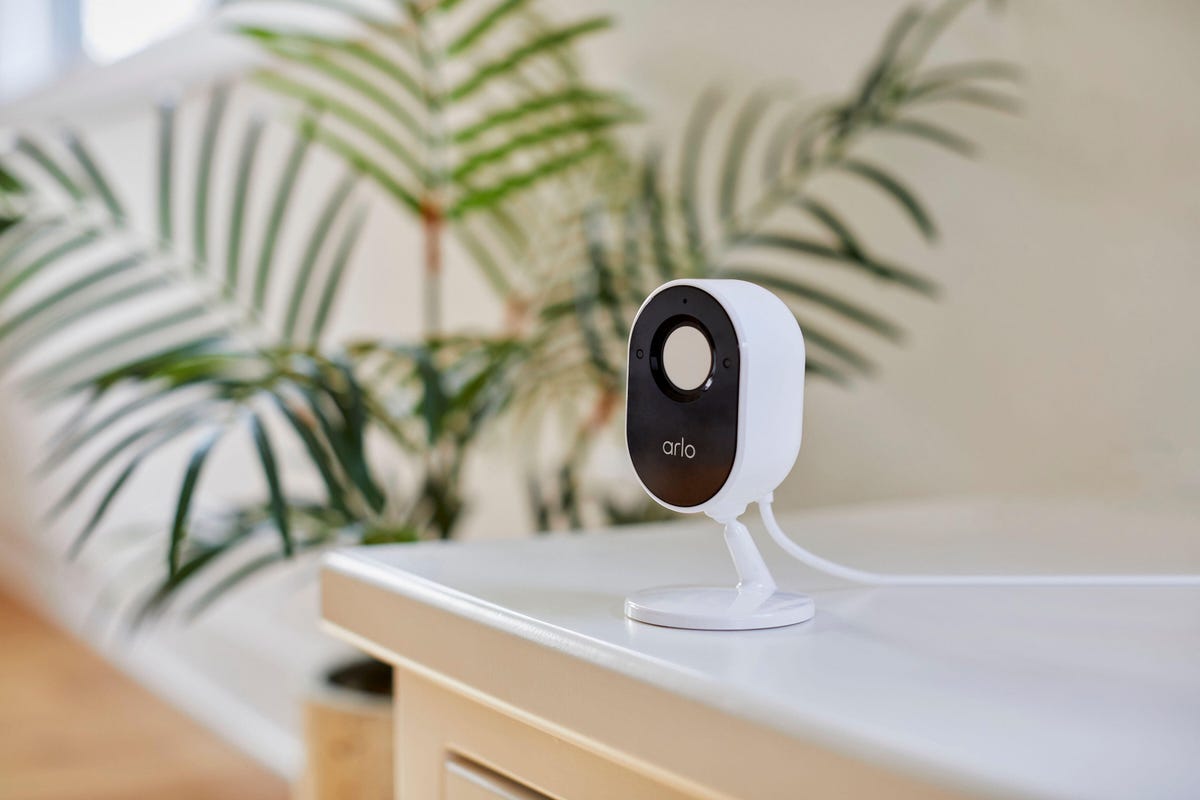

Indoor security cameras are useful, but finding ones with privacy shields are worthwhile, to help minimize the risks of hackers gaining access to sensitive footage.
Arlo
Areas you should not install a security camera
Places that violate your neighbor’s privacy. Cameras are great for your safety, but you need to be mindful of the privacy of others in your neighborhood. Specific laws regarding cameras and privacy vary from state to state, so it’s wise to check local laws (and with the local homeowners association) to make sure you won’t have to undo your installation. In general, homeowners are allowed to have outdoor security cameras that cover a broad area, and it’s usually OK to capture your neighbor’s public-facing property in the background of your footage. Legally, problems arise if your camera captures areas where your neighbors have an expectation of privacy (for example, if your cameras can see into their bedrooms or bathrooms) or if you use the footage for non-security purposes. Keep in mind that these rules apply to video surveillance only. Audio recording without knowledge and consent is illegal in most circumstances.
Bedrooms and bathrooms. The urge to keep a watchful eye on kids or elderly folks in your household is understandable. However, some areas have a warranted expectation of privacy. Plus, if you use a monitoring service, you run the risk of a hacker tapping into a camera that has access to your private spaces. Luckily, there are plenty of alternatives. Baby monitors are smart choices for very young kids’ rooms. Motion detectors and glass break sensors, as part of a connected home security system, can be added to doors and windows. Personal medical alert systems are strong choices for seniors.
Optimize camera placement for function and visibility
Once you decide which locations to monitor, you also need to strategize how you will place and install the security cameras to cover the intended areas.
Guidelines for outdoor security camera placement
- Install cameras 8-10 feet from the ground. This height is low enough to capture fine details but high enough to be out of easy reach of thieves and vandals.
- Don’t point cameras directly at the sun. Bright light causes glare and high contrast in your footage, which makes it hard to tell what’s going on. Consider the movement of the sun and angle your cameras for indirect light.
- Decide whether you want the camera to be visible or hidden. Visible security cameras are effective burglary deterrents, but they are also targets for theft and vandalism. Some homeowners choose to prominently install a fake decoy camera and back it up with a real one that’s slightly more concealed, while others add heavy-duty hardware or casing around the camera to make it more difficult to damage.
- Protect the camera from the elements. Top outdoor security cameras have ample weather- and waterproofing, but they are not all equal. Choose a camera that’s appropriately rated for your climate, and place it under eaves or in another semi-protected area if you can.
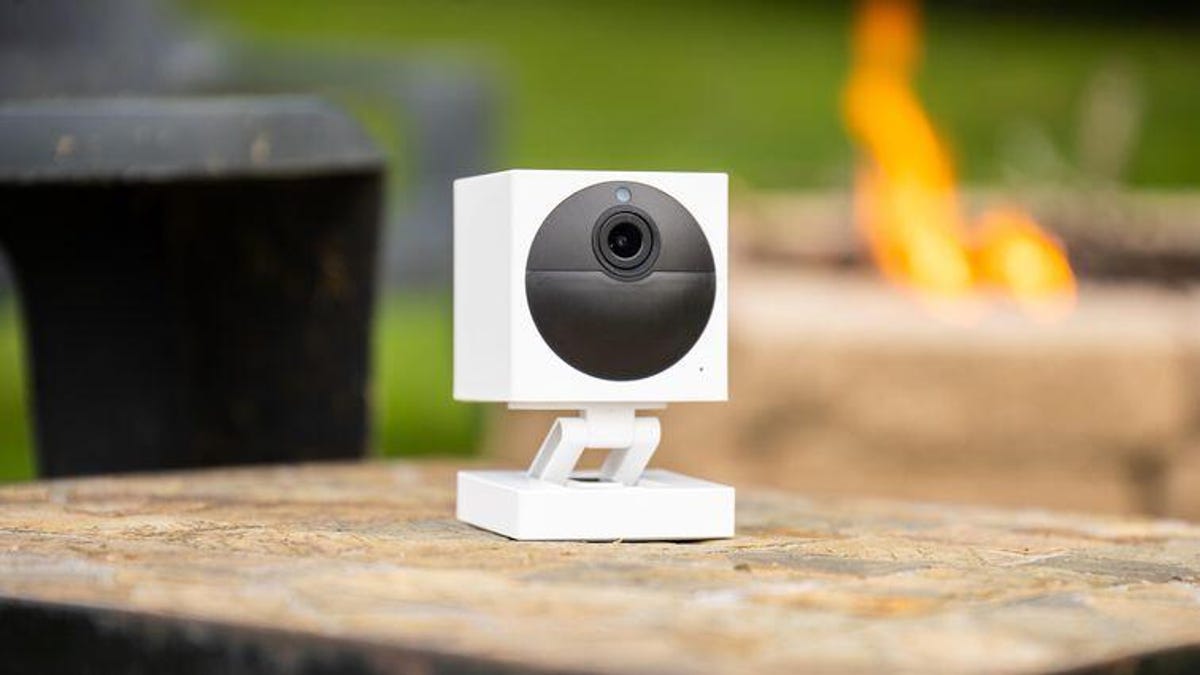

Battery powered outdoor cameras allow more flexibility for placement, while wired ones will need to be close to a power source.
Chris Monroe/CNET
Guidelines for indoor security placement
- Corners are your friends. Hanging an indoor camera in the corner of a room usually gives you the largest possible vantage point.
- Windows can cause reflection issues. Pointing a camera out the window might degrade its image quality. Many security cameras have infrared light technology, which aids in motion detection and enables the cameras to function in low light. IR light can reflect off of windows and other glass objects and obscure your footage, especially in the dark. If your footage looks washed out or whited out, there is likely a reflection problem going on.
- If it’s necessary to point a camera out the window, positioning the lens as close as possible to the glass and/or backlighting the outdoor area (perhaps with motion detector lights) are two glare-minimizing measures to try. It can also be helpful if your camera has wide dynamic range technology.
- Angle for indirect light. Again, direct light will wash out your footage. With indoor cameras, be mindful of lamps, light fixtures and bright windows. Avoid facing your camera directly toward any of these light sources.
Security camera installation tips
Follow these installation rules to potentially save yourself a headache.
- Test your equipment before committing to the full install. Operate the camera in a simple testing spot to make sure it functions as expected. If possible, perform a dry run in the camera’s intended area (mount it with tape, a single nail or another temporary fix) so you can monitor and evaluate the feed. Can you see everything you want to see? Is the Wi-Fi signal strong enough? Is there glare or an obstacle blocking the field of view?
- Don’t install your camera using hardware or tools that may damage its components. It’s tempting to jerry-rig a camera setting to achieve the perfect position. But don’t take measures that could damage or strain the casing, electrical components or lens.
- Remember you will need to occasionally clean or maintain the camera. Outdoor cameras are especially prone to dirt or pollen accumulation on the lens. Don’t install it in a way that makes it impossible to maintain.
Should your security cameras be professionally installed?
The choice between installing your own surveillance cameras or having them professionally installed is ultimately up to you. If the information in this article or the manufacturers’ instructions make your head spin, there’s no need to tackle it alone. However, these devices have gotten increasingly approachable and accessible over time and are often set up for simple self-installation.
Security cameras that you’ll be monitoring yourself (as opposed to professionally monitored security systems) usually have the simplest installation. Many of these cameras communicate via Wi-Fi and only need hard wiring to their power source. Smaller cameras like video doorbells and peephole cameras frequently use batteries, which is even more user-friendly. Outdoor security cameras can present more of a challenge, especially if the home’s exterior has limited power sources, if you don’t have many tools or if you are concerned about affecting your home’s appearance. In these cases, you may want to hire a professional with experience on prior camera installs.
Finally, there are some circumstances where you can’t install your own cameras. Many leading providers of monitored home security systems (such as ADT and Vivint) require professional installation to make sure everything is in working order. In these cases, a trained technician visits your house to relieve you of this responsibility altogether. If you’re dedicated to doing it yourself and you want a professionally monitored security system, you do have plenty of DIY options.
To learn more, check out our picks for the best outdoor security cameras or explore our comprehensive guide to the best home security systems.
Best Home Security Systems for 2022

The post 6 Places Every Home Should Have Security Cameras first appeared on Joggingvideo.com.
]]>The post Amazon’s Blink Adds a Wired Floodlight Camera and a Pan first appeared on Joggingvideo.com.
]]>
Blink, the Amazon-owned smart home security camera brand, announced a pair of new products Wednesday at Amazon’s September hardware and services event: a Wired Floodlight Camera that costs $100, and a new $30 Pan-Tilt mount for the Blink Mini that’ll let you adjust the viewing frame up and down or left and right.
The former is built for outdoor use, with its built-in floodlights offering up to 2,600 lumens of light whenever they detect motion. The wired design eliminates the need to worry about batteries while offering anytime access to the 1080p video feed in Blink’s app, as well as two-way talk capabilities. Support for Amazon’s Alexa lets you pull up the feed on a compatible Fire TV or an Echo Show smart display with a quick voice command.


Blink Wired Floodlight Camera
Price: $100Release date: Q4
The wired floodlight camera delivers 2,600 lumens of light whenever it detects motion without needed batteries, and you can you pull up the feed on a compatible Fire TV or an Echo Show smart display with a quick voice command via Alexa.
$100 at Amazon
Blink adds that the camera is built around Amazon’s AZ2 Neural Edge Processor, which enables enhanced motion detection features like person detection and activity zones, while also enabling footage to be processed locally on the device itself instead of in Amazon’s cloud. You can store footage locally, too, provided you’re using a USB flash drive and a Sync Module 2, each sold separately — otherwise, you’ll need a Blink subscription plan to store video clips and images on Amazon’s servers. A Blink spokesperson tells CNET that the new camera will be available for purchase on Amazon within the next few months.
New product No. 2 isn’t a camera at all, but a motorized mount for the Blink Mini, a budget-priced indoor camera that costs $35. Dubbed the Blink Mini Pan-Tilt and available for preorder starting today at $30 — or $60 packaged with the camera — the mount is built to turn the Blink Mini left and right, or to tilt it up and down, all of which users can control from the Blink app to adjust the direction the camera’s pointing in.


Blink Mini Pan Tilt mount
Price: $30 or $60 bundled with the cameraRelease date: In preorder now
What it says on the tin: It’s a motorized mount for the Blink Mini that allows you to pan left and right and tilt up and down via the app for better remote viewing.
$60 at Amazon
The new Blink products reflect Amazon’s growing focus on selling cameras and camera-equipped gadgets for the smart home. It’s not just Blink — at the same event, Amazon also revealed new spotlight cameras for the Ring lineup, as well as new Echo devices with built-in cameras and a virtual security guard use case for Astro, the camera-equipped patrol bot.


Now playing:
Watch this:
Watch Every Product Announced at Amazon’s Devices Event
9:35
“The Blink Wired Floodlight Camera is our first wired floodlight device, and it adds to the existing lineup of easy-to-use, reliable, and affordable security devices that help customers keep an eye on their homes,” said Mike Harris, Blink’s chief operating officer. “Plus, it leverages the intelligence of Amazon silicon, enabling features such as computer vision and local video processing for the first time.”
The Blink Mini Pan-Tilt is available for preorder on Amazon starting today, while the Blink Wired Floodlight Camera is set to hit the market within the coming months. We’ll keep an eye out for each and let you know once we’ve had a chance to test them out.
More from Amazon’s event
- Amazon Event Live Blog: Kindle Scribe, Halo Rise, Astro and More
- Amazon’s Halo Rise Is a Sleep Tracker You Don’t Have to Wear
- Kindle Scribe Is an E Ink Tablet With Stylus for Notation Nerds
- Amazon Fire TV Omni QLED Knows When You Enter the Room
The post Amazon’s Blink Adds a Wired Floodlight Camera and a Pan first appeared on Joggingvideo.com.
]]>The post Here’s What the iPhone 14 Pro’s Cameras Can Do first appeared on Joggingvideo.com.
]]>This story is part of Focal Point iPhone 2022, CNET’s collection of news, tips and advice around Apple’s most popular product.
The iPhone 14 Pro’s camera upgrades should appeal to photographers, filmmakers and creative types on TikTok and YouTube. Apple made several significant improvements to the iPhone’s camera hardware, like adding a larger, 48-megapixel sensor. The 14 Pro also uses Apple’s revamped image processing system, which is supposed to improve image quality in darker environments. Factor in the new A16 Bionic chip, and you get features like a new video stabilization mode, the ability to film Cinematic mode videos in 4K, higher resolution ProRaw photos, and pictures and videos with better image quality when captured in medium- and low-light situations.
Read more: iPhone 14 Pro and 14 Pro Max Review: Welcome to Apple’s Dynamic Island
I used the iPhone 14 Pro as my main shooter for a week to document two of my favorite places in San Francisco: the Mission District and the Embarcadero. I encountered fog, beer, a collegiate marching band and various tacos, and I used the iPhone 14 Pro to chronicle them all. I ended up with hundreds of photos and dozens of video clips on the 1TB iPhone 14 Pro review sample that Apple had lent me.
Get up to $720 off the iPhone 14 Pro with a trade-in
$279 at Apple
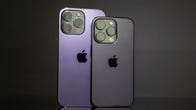
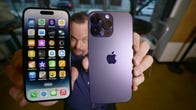

Now playing:
Watch this:
iPhone 14 Pro and 14 Pro Max Review: Tons of Upgrades,…
14:11
The iPhone 14 Pro and its 48-megapixel camera
The iPhone 14 Pro has three rear cameras: a main wide-angle camera, an ultrawide, and a telephoto camera with 3x optical zoom. The lens on the main camera has a wider focal length, going from a 26mm equivalent on previous iPhone models to a 24mm one. It isn’t drastically different, but it helps get more of the scene into the frame.


Just a cat under mixed lighting, as captured by the iPhone 14 Pro.
Patrick Holland/CNET
The main camera also gets a new, larger, 48-megapixel sensor. Though more megapixels doesn’t necessarily mean better photos, Apple divides the pixels into groups of four and combines the four in each group into one larger pixel. This technique is called pixel binning, and it’s been used on Android phones for years. The results are brighter photos that have less image noise (and as a bonus, less noise-reduction blur). Apple’s new imagining pipeline, called the Photonic Engine, takes things further and helps improve color accuracy and protect details. Take a look below at a photo I shot of a streetcar just after sunset. Pay special attention to the texture of the pavement and the details in the leaves and building behind the streetcar. This isn’t the best photo I took with the iPhone 14 Pro, but it shows how the camera handles an everyday situation when things aren’t bright and sunny. The photo’s contrast is a bit much, and I’d likely reduce it when I edited the picture, or set up a Photographic Style with less contrast.


I took this photo just after dusk. Notice how the 14 Pro was able to get a bright exposure without a lot of light.
Patrick Holland/CNET
The main camera takes excellent photos. The image quality and details look great for a phone photo. I noticed that the most improvement came in medium- and low-light situations. Colors and textures look good. Check out the photo below, which I took on a foggy morning. Notice the textures in the buildings’ bricks and the way the 14 Pro captured the fog gradually engulfing the top of Salesforce Tower.
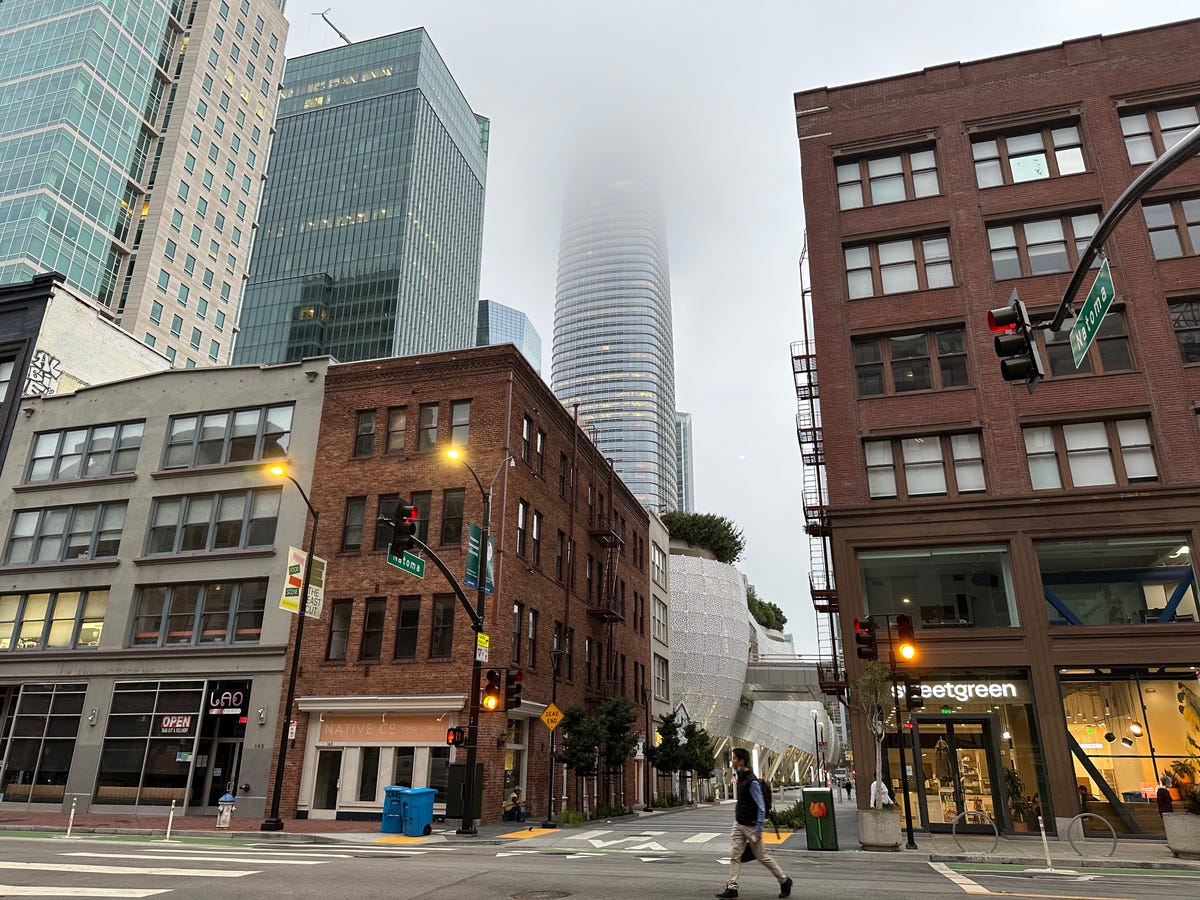

When I took this photo, there was a lot of fog. Notice the details the 14 Pro was still able to capture.
Patrick Holland/CNET
For the past year, I’ve mainly used an iPhone 13 Pro as my daily driver. During the week I had the 14 Pro, I saw an improvement in the photos I took. Image detail was better, due in part to the new Photonic Engine processing pipeline. Check out the photo below of a cookie and cappuccino from Four Barrel Coffee, a hip java spot in the Mission.


Vegan fudge cookie, oat milk cappuccino.
Patrick Holland/CNET
The photo below was shot under a palm tree’s dark canopy. The 14 Pro boosted the brightness and did a solid job of capturing the different textures in the stem and fronds.
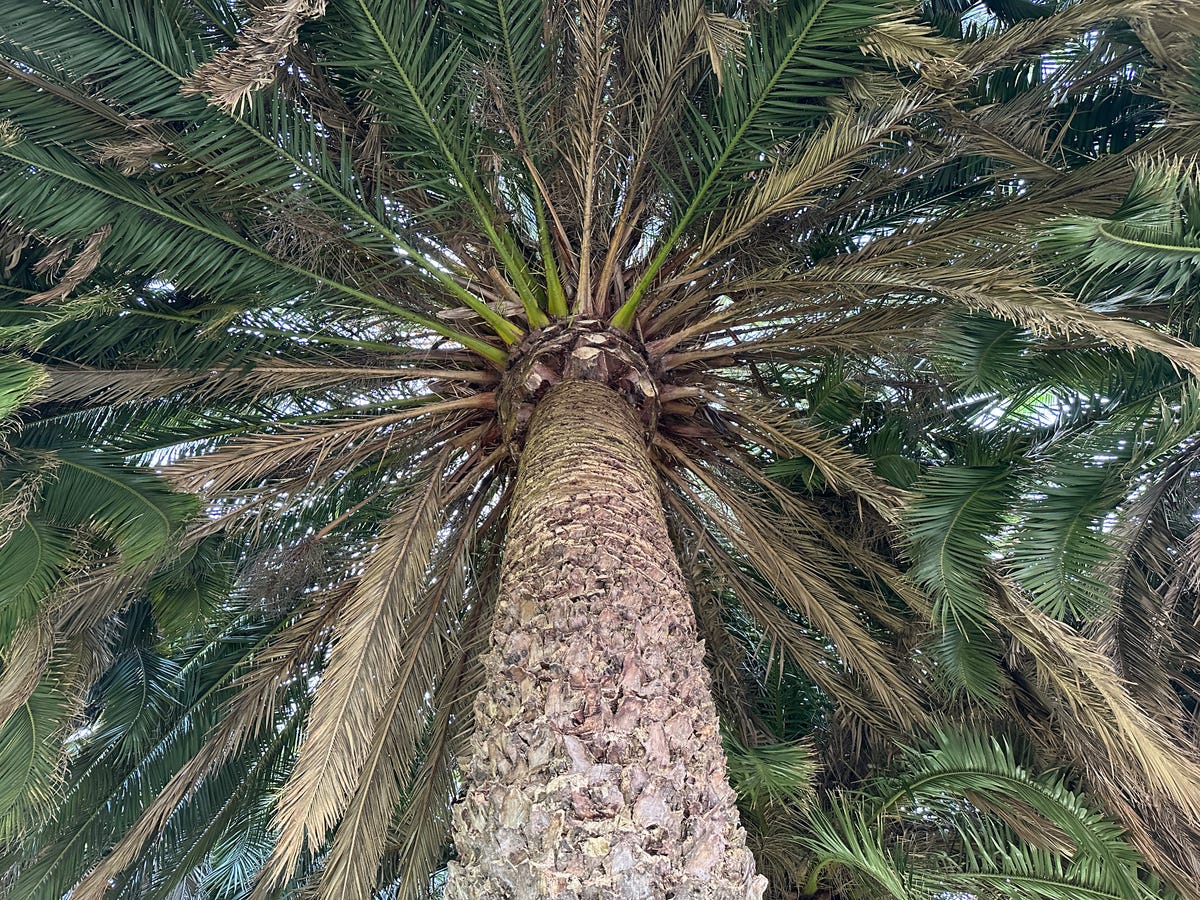

Notice the textures.
Patrick Holland/CNET
If you’re so inclined, you can capture 48-megapixel photos using the phone’s ProRaw setting. I should warn you that these files are big. The file for the photo below of the Bay Bridge at sunset is 48 megabytes. After editing, the photo is saved as a much smaller JPEG. Look closely at the sky’s color gradient, and the details of the cars and the bridge’s support cables.


This photo was taken with the full 48-megapixel resolution of the main camera’s sensor and saved as an Apple ProRaw file.
Patrick Holland/CNET
Night mode on the iPhone 14 Pro
When the iPhone 11 series launched in 2019, it included Night mode, which takes a series of images over a few seconds and combines them to create a photo that’s brighter and has better colors and less image noise. Three years later, on the 14 Pro, Night mode has blossomed even more. Capture-times are much faster. Most of the time, Night mode needed just a couple of seconds to get a good photo in a bar or other dark locale.
Take a look at the photo below that I took indoors at Zeitgeist in the Mission. Essentially, all the lights are pointed at the walls, leaving the middle of the bar a dark void that’s a perfect place for punk Gen Xers and millennials to sip their IPAs in quiet angst. Night mode took two seconds to capture this photo. It did a great job balancing the bright lights on the red sign-filled wall with the dark middle of the bar. Though most of the people are in shadow, the 14 Pro did a solid job of capturing skin tones.


This bar was pretty dark, but look closely at the detail in the signs and in people’s skin tones.
Patrick Holland/CNET
The photo below is of Taqueria El Buen Sabor, a terrific place for some post-drinks burritos. It was very dark and I used Night mode to take the photo. This isn’t my best Night mode snap with the new phone, but it shows what’s capable under a less than ideal situation. Had I put the phone on a tripod for a longer Night mode exposure time, or if the lights weren’t as bright (compared with the dark cloudy sky), I think it would’ve been a better photo. But it’s still decent. There’s some image noise in the cloudy sky, and the details in the building are a little soft.
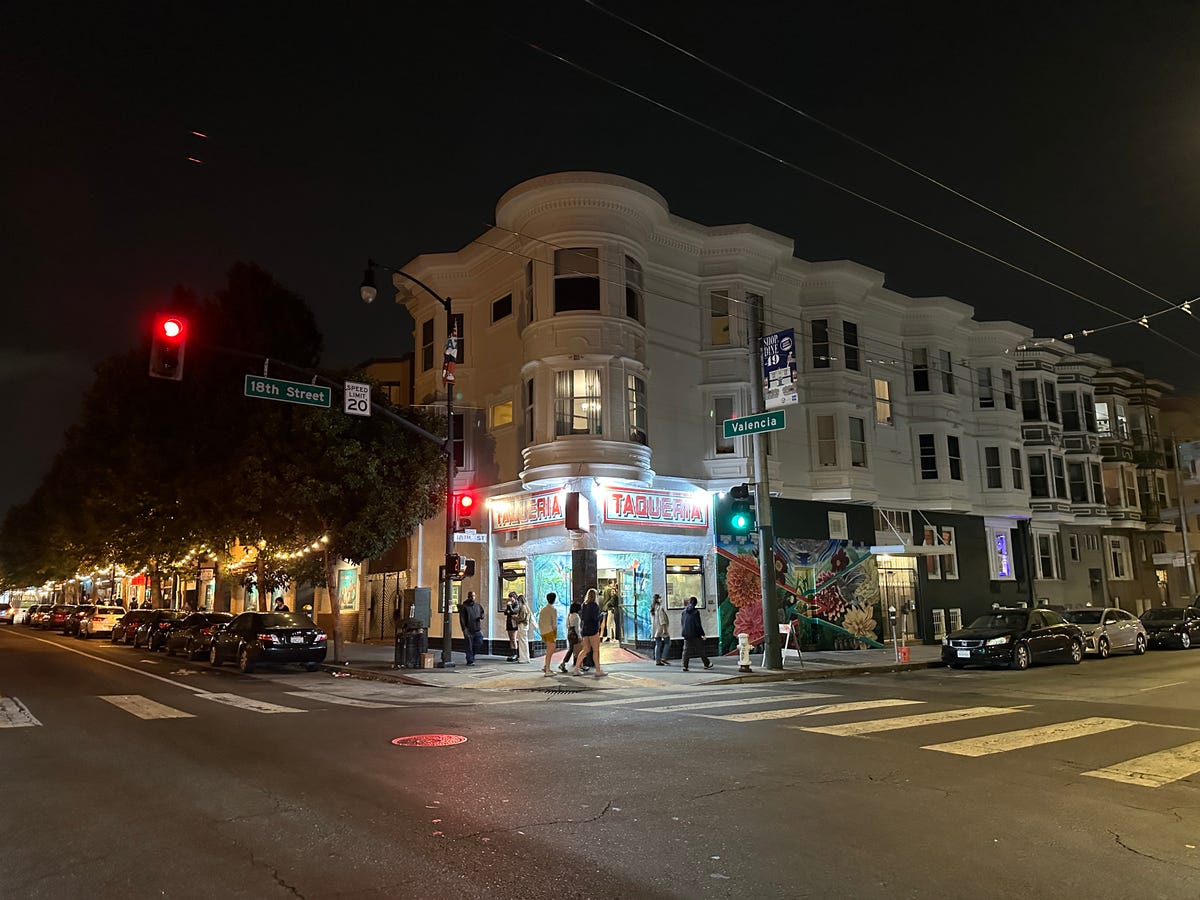

This was taken around 11 p.m., using Night mode.
Patrick Holland/CNET
I visited another Mission taco spot, Tacolicious, with some friends. (I warned you there were lots of tacos in this review.) The snap below was taken with Night mode. It wasn’t as dark as when I took the other two Night mode photos, but it definitely wasn’t overly bright either. Pay close attention to the texture of the tortillas and the detail of the cilantro. I was hand-holding the 14 Pro, and I’m proud of the results.


Night mode tacos, anyone? (Sorry if you’re one of those folks who can’t handle cilantro.)
Patrick Holland/CNET
The iPhone 14 Pro’s ultrawide camera gets a new lens
The ultrawide camera gets a new sensor, with more focus pixels and a stepped-down f/2.2 aperture lens. All this adds up to much sharper ultrawide photos. The sensor, combined with the Photonic Engine, helps improve image quality in less than ideal situations. Ultrawide photos and videos are still a step down compared with those from the main camera, but these improvements are welcome.
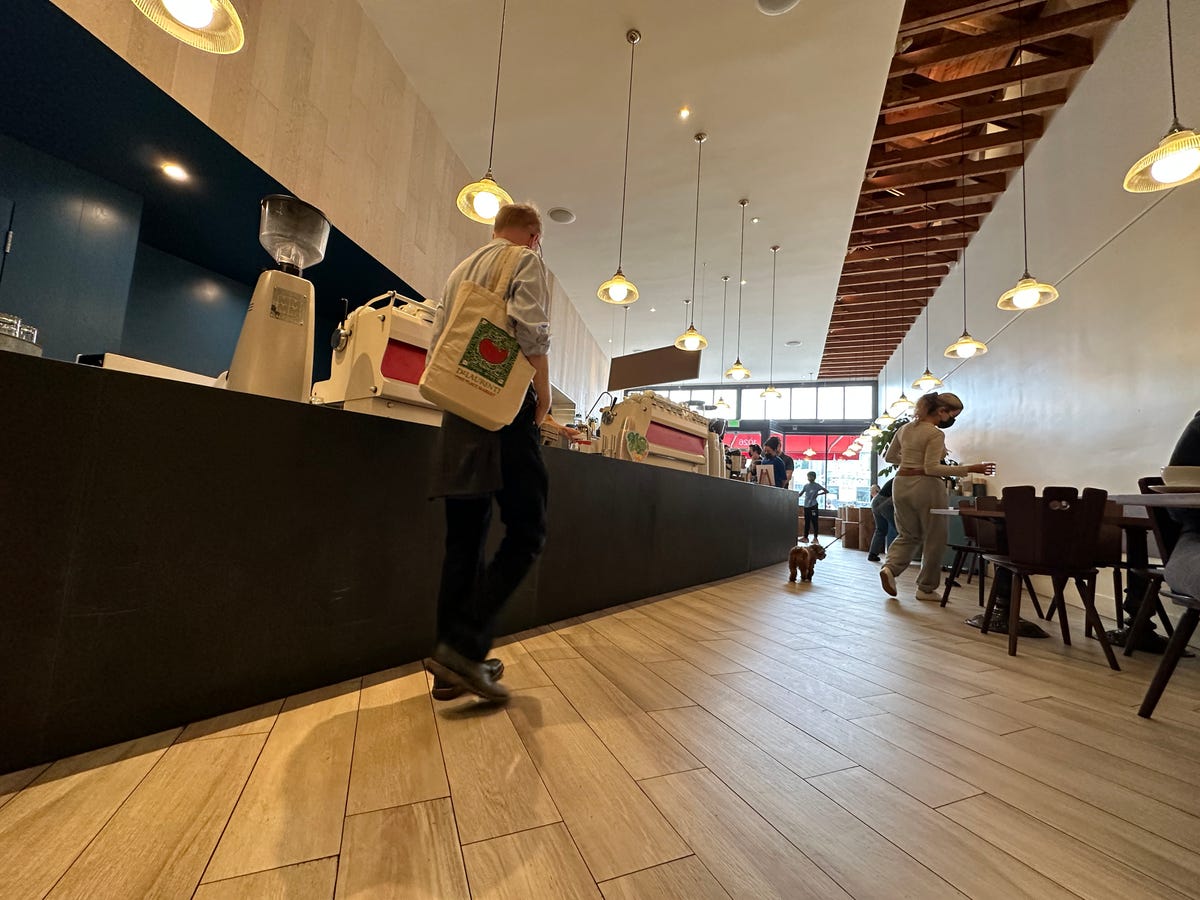

I like the dramatic look the ultrawide camera gave to this scene of a man walking toward a coffee counter.
Patrick Holland/CNET
Below is a great example of the limits of the 14 Pro’s ultrawide camera. In particular, notice how the highlights in the sky are blown completely out to white.
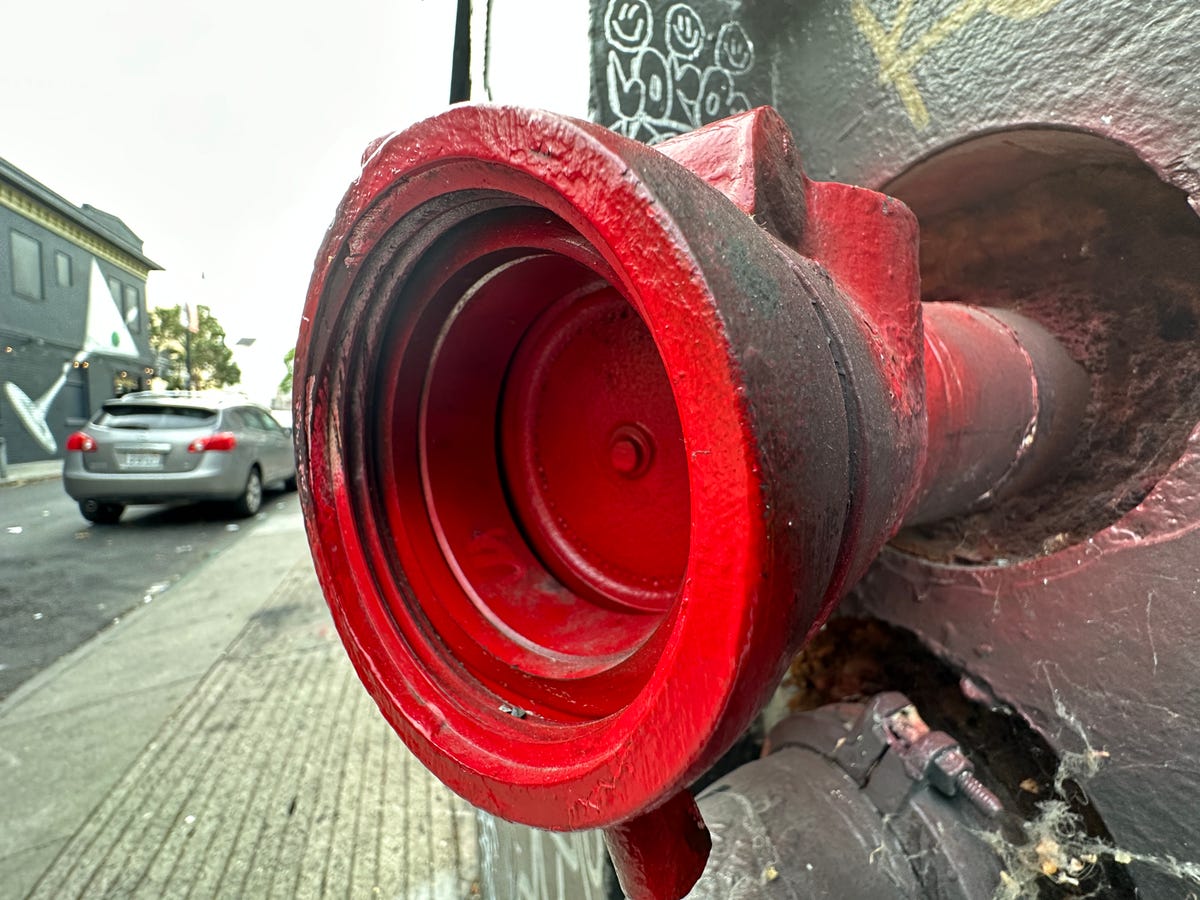

I used the 14 Pro’s ultrawide camera to take this shot of a red pipe on the side of a building.
Patrick Holland/CNET
Macro photos also get a boost from the ultrawide camera upgrades. When you try to take a photo with the main camera and are standing very close to a subject, the iPhone 14 Pro switches to the ultrawide camera and crops the framing to mimic the main camera. This allows for a closer focus, which is great for close-up shots of small things.
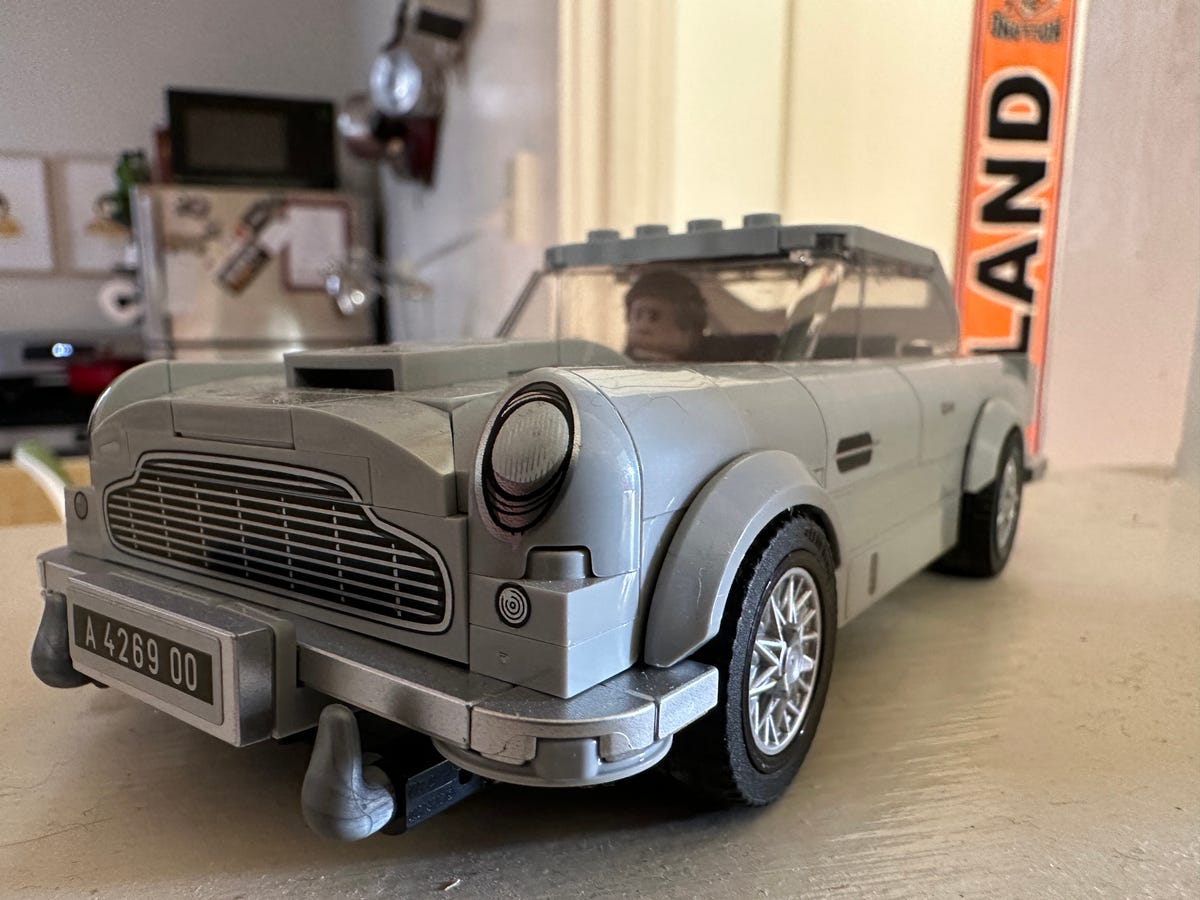

Macro mode lets you get within inches of your subject and have it be in focus, like this Lego car.
Patrick Holland/CNET
Last year’s 13 Pro had a similar feature, but with the new ultrawide, macro photos have better image quality, especially in medium and low light.
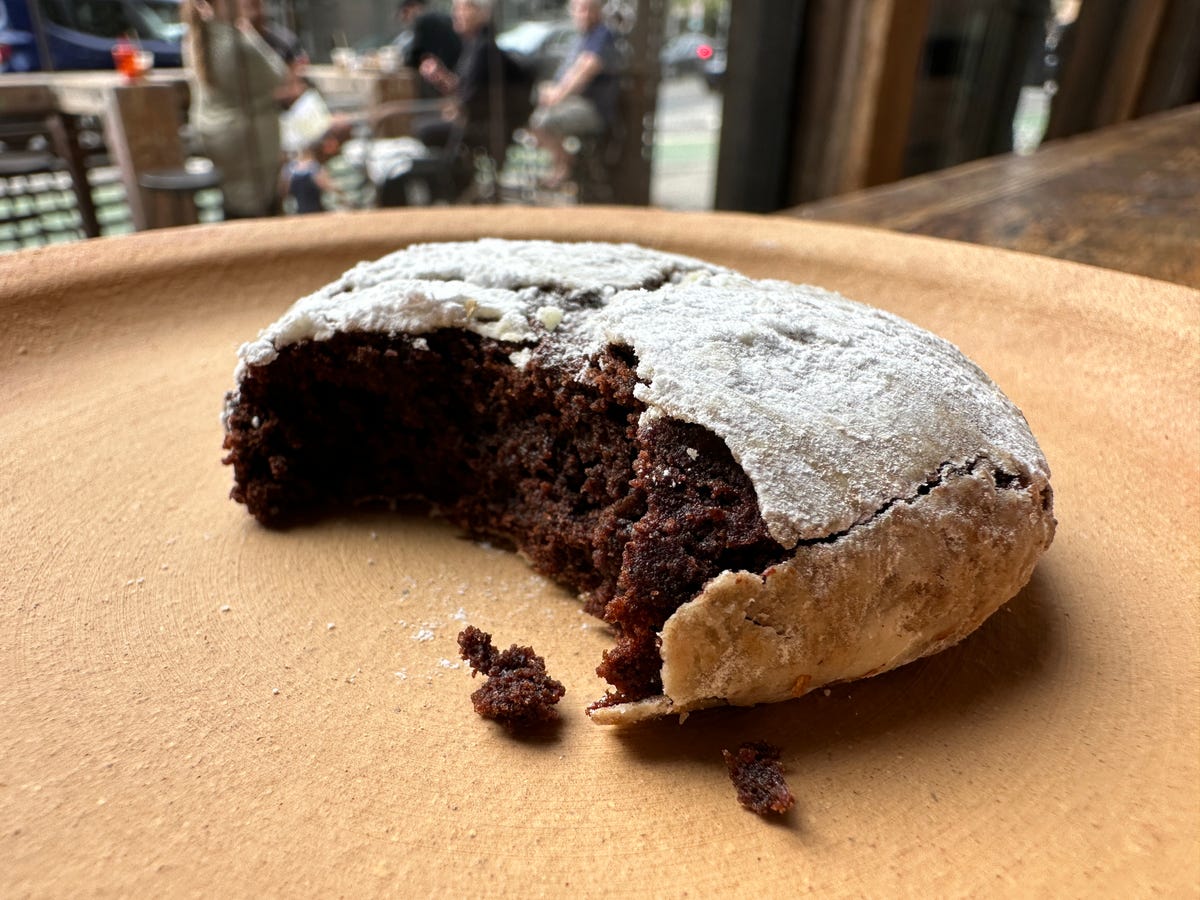

Another macro photo from the 14 Pro.
Patrick Holland/CNET
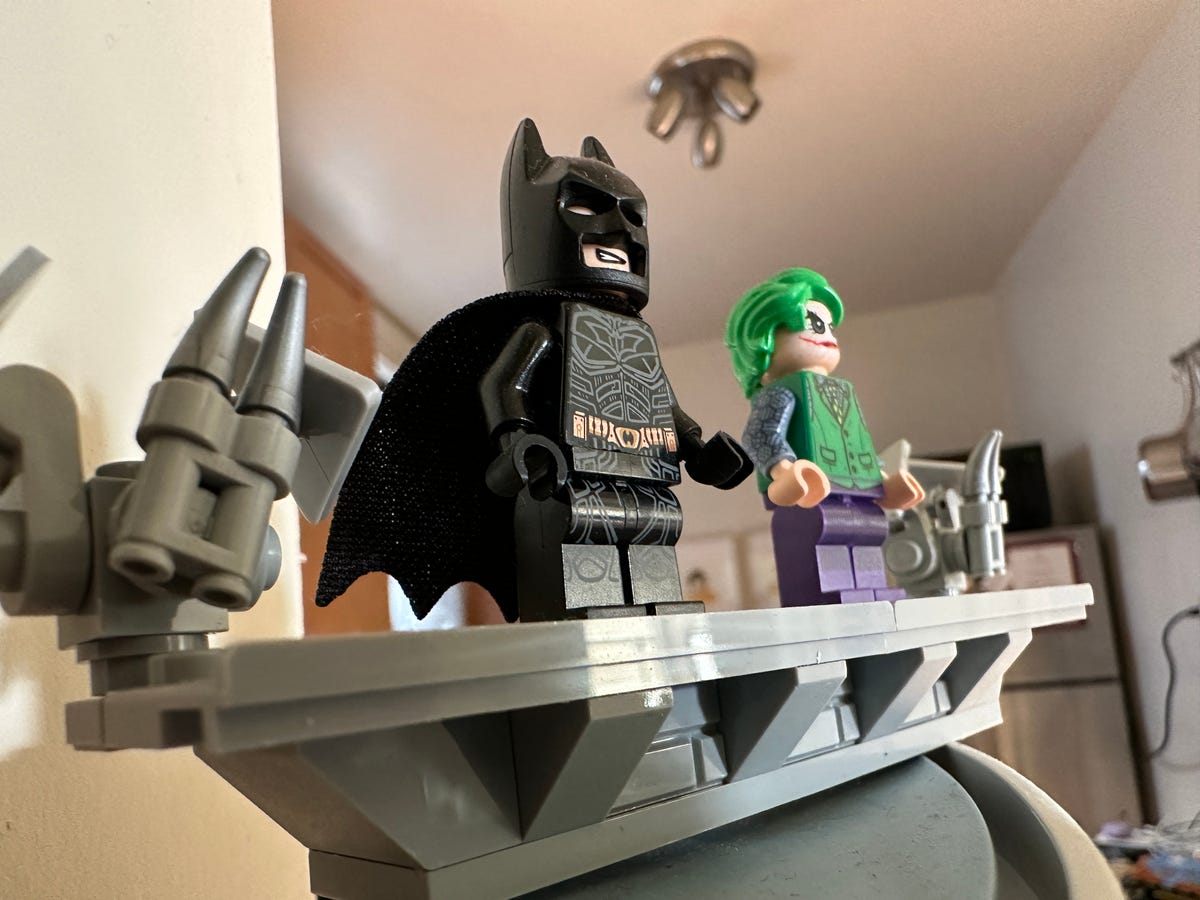

The 14 Pro nails the focus on Lego Batman in this macro photo.
Patrick Holland/CNET
The 14 Pro’s telephoto camera has a 3x optical zoom
The telephoto camera is basically identical to the one on last year’s 13 Pro, but it gets a lift from the 14 Pro’s Photonic Engine. Under good lighting, like in the picture below, the telephoto camera takes good photos. Notice in particular the colors and how the camera handles skin tones.


A telephoto shot of folks noshing in a parklet.
Patrick Holland/CNET
As with the ultrawide, image quality is a step behind the main camera — especially in dimmer environments.


I took this photo of the Embarcadero’s Ferry Building during blue hour, with the 14 Pro’s telephoto camera.
Patrick Holland/CNET
Below is a Portrait mode picture of Maisie the cat taken indoors with the telephoto camera. The 14 Pro and its Photonic Engine did a good job of finding the white balance and capturing the detail’s in Maisie’s fur.


The telephoto camera has an equivalent lens length of 77-millimeters, which is perfect for portraits.
Patrick Holland/CNET
Summer in San Francisco can be foggy, as you can see in the telephoto shot below. I’m impressed by how the 14 Pro was able to pull out the clouds from the otherwise concrete-colored foggy sky. Equally impressive is how well the 14 Pro was able to freeze the action of the guy in the bottom right playing stick toss.


Even on a foggy September day, people venture out to the Mission’s Dolores Park to relax, play, and see friends and family.
Patrick Holland/CNET
Your selfies look better with the iPhone 14 Pro
The TrueDepth camera got an upgraded lens with a brighter f/1.9 aperture. The selfie camera has autofocus for the first time ever on an iPhone. The autofocus works great for group selfies. Take a look at the selfie below of me and my CNET colleague Jessica Fierro.


The front-facing camera now has autofocus.
Patrick Holland/CNET
Maybe it’s because of the new Photonic Engine, but selfies look better. Previous iPhones rendered selfie photos that look muted and almost dull. The 14 Pro’s front-facing camera has better definition and a lighter touch with the way it handles skin tones.


The 14 Pro did an excellent job at capturing how I actually looked when i took this photo. And yes, I was very tired. Probably all those late-night tacos.
Patrick Holland/CNET
The iPhone 14 Pro shoots excellent videos
All the improvements to the cameras and processing also make videos look even better. Apple made it so that Cinematic mode can now record in 4K and at 24 frames per second. There’s a new video image-stabilization tool, called Action mode. When you shoot a video, you can toggle it on and the phone crops in a bit to keep the image centered and the horizon level. If you’re shooting in 4K, Action mode drops the resolution to 2.8K, but the results are still impressive. Though other phones, like the Galaxy S22 Ultra, have similar stabilization functions, it’s wonderful to see the tool come to the iPhone. And it works across all three rear cameras.
During my Action mode tests, I was reminded of just how good the image stabilization is in regular video mode. Check out the video below to see the clips I shot with the iPhone 14 Pro and 14 Pro Max. The clips included videos shot in Action mode, slow motion, regular video mode and Cinematic mode.
Final thoughts
The iPhone 14 Pro represents one of the largest improvements to the iPhone’s cameras in years. In places with less-than-ideal lighting, I found improvements when I took photos and recorded videos. The iPhone 14 Pro also continues Apple’s reign when it comes to recording the best videos of any phone in terms of image quality. I look forward to taking more snaps and shooting more video clips.
iPhone 14 Pro, Pro Max Get the Biggest Changes to Apple’s Phone Lineup
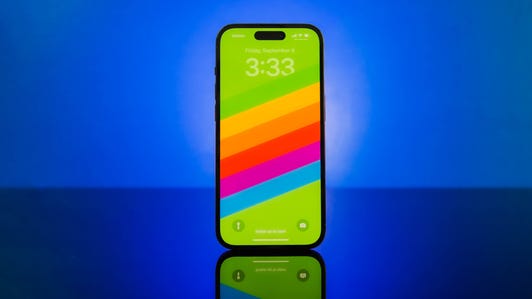

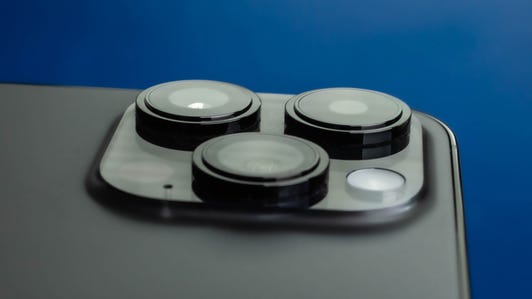

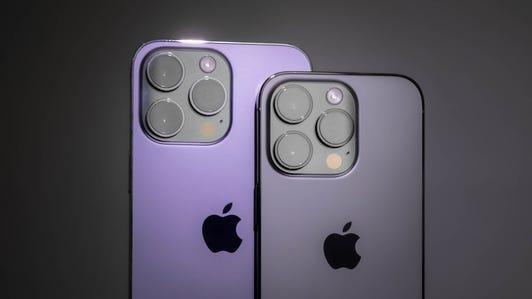

+8 more
The post Here’s What the iPhone 14 Pro’s Cameras Can Do first appeared on Joggingvideo.com.
]]>The post Missing Some iOS 16 Features? Your iPhone’s Age Might Be to Blame first appeared on Joggingvideo.com.
]]>This story is part of Focal Point iPhone 2022, CNET’s collection of news, tips and advice around Apple’s most popular product.
The new iOS 16 is out now for compatible iPhones, which means you can download it right now if you have an iPhone 8 or newer.
Unfortunately, even if your iPhone is capable of running iOS 16, that doesn’t mean it will get all the cool new features, like the battery percentage icon in your status bar or the new drag-and-drop photo crop trick.
Depending on your iPhone’s age and processor, your software update may be lacking some of the new settings and features that others are enjoying on iOS 16. Here’s how to find out if you might be missing these features too.
Read more: Should You Upgrade to the iPhone 14? How It Compares to Older iPhones
If you’re interested in getting the iPhone 14, 14 Pro or 14 Pro Max, which arrived Friday and will include every single feature in this list, here is how you can find an iPhone 14 deal and here are some of the best cases you can get.
Battery percentage in the iPhone status bar
Apple used to show off the battery percentage in the status bar until the release of the iPhone X and the notch (which has recently been converted to the Dynamic Island). With iOS 16, the battery indicator has been reintroduced and redesigned — but not for everyone with the latest update.
According to this Apple support page, the status bar battery feature is excluded from the iPhone XR, iPhone 11, iPhone 12 mini and iPhone 13 Mini.
If you want to see a visual indicator of your battery’s charge, you can either add a battery widget to your home screen or swipe down to view the number in the Control Center.
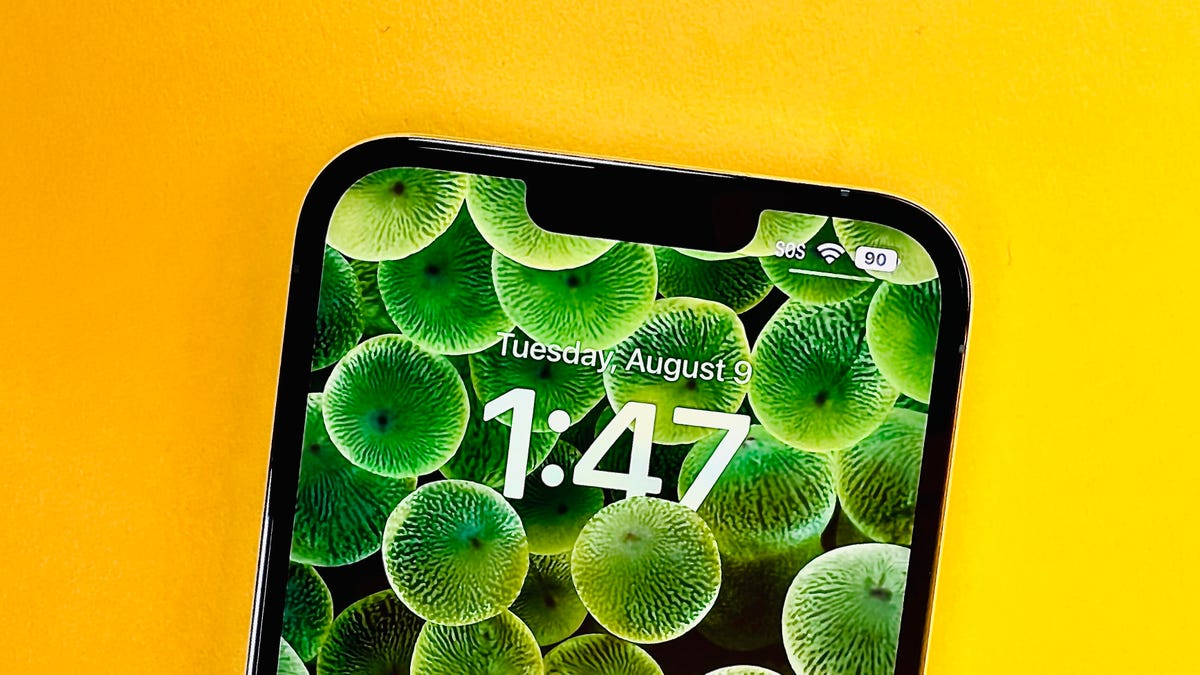

The battery icon lives in the top-right of the iPhone.
Patrick Holland/CNET
Lift subject from photo background
On iOS 16, you can press your finger down on a clear subject, such as a person or a pet, in a photo, to crop it out and then drag and drop it elsewhere, like in your notes, an email or a text message. It does this using Apple’s Visual Look Up feature, which identifies objects in your photos, but both of these features require newer iPhone models.
This feature is available only on an iPhone with a A12 Bionic and later — starting with the iPhone XS/XR — and is not be available on the iPhone X and iPhone 8 series.
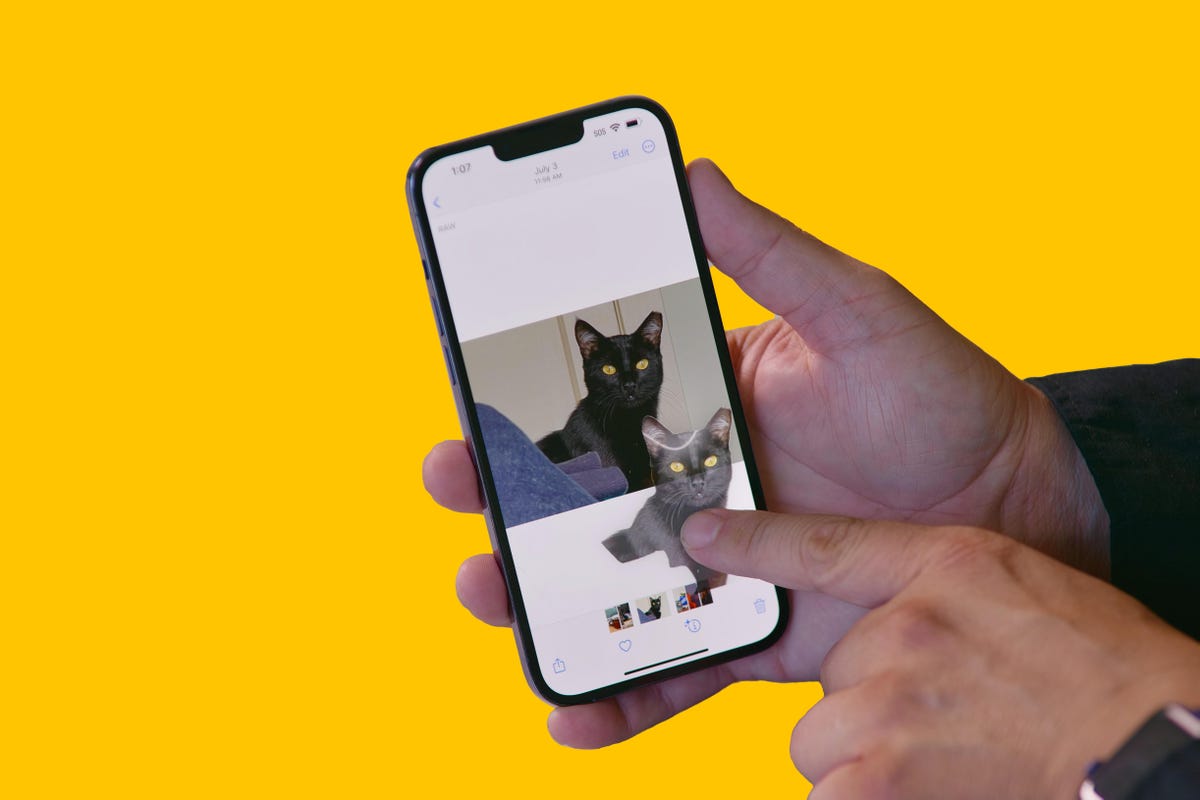

Simply drag and drop to crop your subject from a photo.
Celso Bulgatti/CNET
Wallpaper depth effect on your lock screen
The lock screen added major customization tools with the release of iOS 16, allowing you to play with fonts, colors, wallpaper profiles, widgets — and a new depth effect. As long as your wallpaper features a clear subject in the foreground, the time on your lock screen may appear underneath the object, giving your wallpaper a layered effect. However, the feature also uses Visual Look Up to identify your subject, and so it won’t work on every iPhone.
Once again, this feature is available just on an iPhone with a A12 Bionic chip and later, so iPhone XS/XR and later.
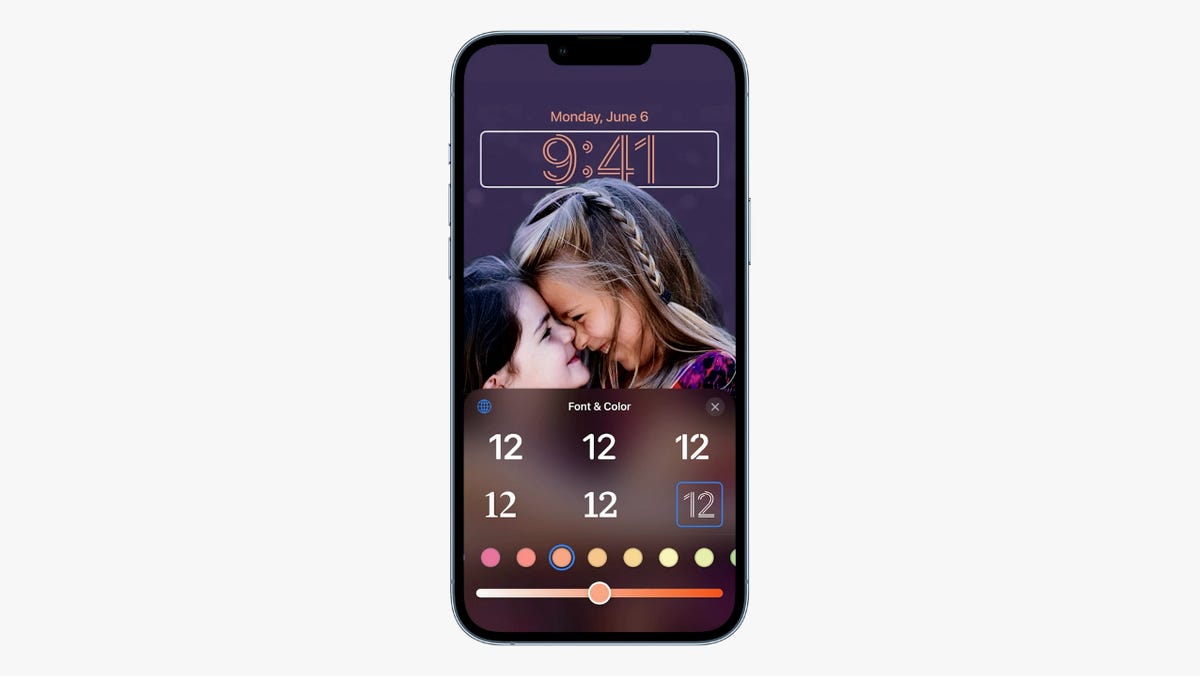

You can see the bottom of the time fall back behind the photo’s subject.
Apple/Screenshot by CNET
Live Text to copy text from videos
The Live Text feature on your iPhone, which was introduced with iOS 15, allows you to copy text from an image and then paste it elsewhere. With iOS 16, the feature has received an update which now lets you copy text from a paused video as well, but only if you have a certain iPhone.
This feature is available only on the iPhone XR/XS and later.
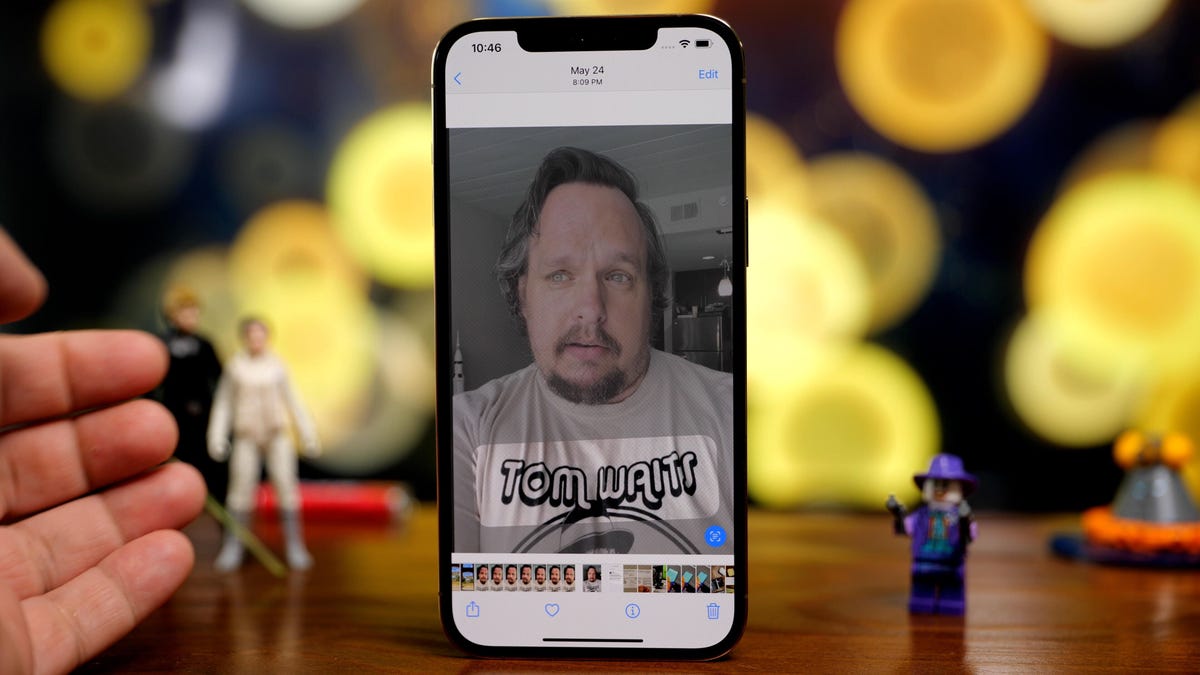

Live Text works on both photos and videos on iOS 16.
Patrick Holland/CNET
New and improved Dictation experience
In iOS 16, Apple has redesigned how Dictation works, making it easier to use voice-to-text and the keyboard together, making the experience more fluid when sending text messages and drafting up emails. The feature uses on-device machine learning, which unfortunately isn’t available on all iPhones.
This feature is once again only available on iPhones with a A12 Bionic chip and later, which includes the iPhone XS/XR and later.
Live captions for FaceTime calls and videos
Live Captions for iOS 16 creates real-time captions for any video playing on your iPhone, whether it’s in your text messages or camera roll, or even if it’s a FaceTime call. The new accessibility feature is geared toward improving communication for those that are hard of hearing, but not everyone will get the change to enable it.
Like most of the features on this list, it’s only available on iPhone models with the A12 Bionic chip and later, which includes the iPhone XS/XR and later (and leaves out the iPhone 8 series and iPhone X).
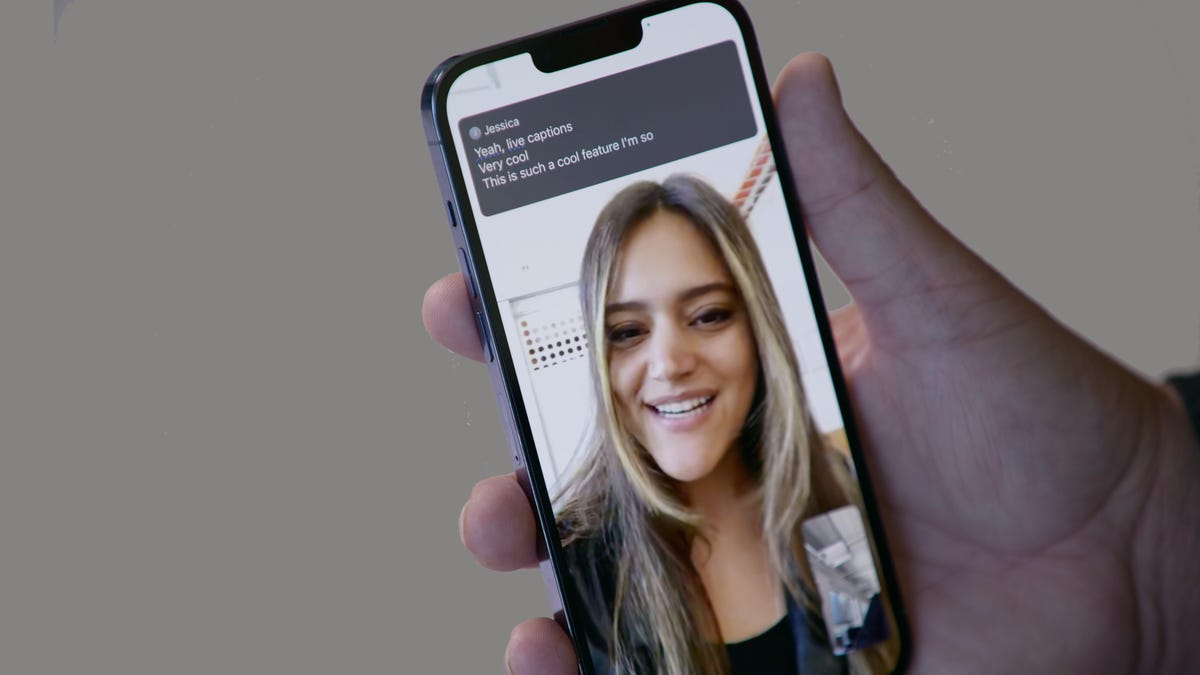

Live Captions on FaceTime allow you to read what the other person is saying in realtime.
Celso Bulgatti/CNET
Other features not available for every iPhone running iOS 16
The features above aren’t the only new or updated features that won’t appear on every iPhone with iOS 16. Below is a full list of missing features and which iPhone models are included.
- Blur foreground objects in portrait photos: Available on the the iPhone 13 and iPhone 14.
- Use your camera to track your medications in the Health app: iPhone XS/XR and later.
- Hang up calls using your voice and other Siri improvements: iPhone XS/XR and later.
- Detect and describe nearby objects, like doors, with your camera: Available on the iPhone 12 Pro, iPhone 13 Pro and iPhone 14 Pro.
For more, here are the first things to do once you get iOS 16 and how to turn off iOS 16’s annoying features.
The post Missing Some iOS 16 Features? Your iPhone’s Age Might Be to Blame first appeared on Joggingvideo.com.
]]>The post The iPhone 14’s Newest Features Have Been on Android for Years first appeared on Joggingvideo.com.
]]>This story is part of Focal Point iPhone 2022, CNET’s collection of news, tips and advice around Apple’s most popular product.
With the iPhone 14 now on sale, people can experience some of the “breakthroughs” Apple touted during its reveal event. But for those on Android, some of these upgrades are very familiar.
Chalk it up to Apple’s much-touted “reality-distortion field.” It’s also a reminder to not take every claim at face value. While reviews for the iPhone 14 and the iPhone 14 Pro are strong, it’s best to look at any upcoming big purchase decision — the Pro starts at $999 — with proper context.
Here’s a breakdown of all the features coming to the iPhone 14 that were first on Android.
Apple’s Newest Releases
- iPhone 14 Pro, Pro Max Review: Welcome to Apple’s Dynamic Island
- iPhone 14 Review: A Good Upgrade for Most People
- Apple Watch Series 8 Review: Improvement By Degrees
- Apple Watch SE Review: Almost Everything I Want
- Apple iOS 16 Released: New iPhone Features From the Update
Android did it before iPhone 14: Pixel binning


The iPhone 14 Pro has three main cameras: the wide angle at 1x zoom, the ultrawide at 0.5x, and the telephoto at 3x. Using the central pixels of the main camera’s 48-megapixel sensor means there’s in effect a fourth camera at 2x zoom.
Apple; Screenshot by Stephen Shankland/CNET
The iPhone 14 Pro will be the first iPhone to get a 48-megapixel camera. The pixel count is four times greater than for the standard iPhone 14 and last year’s iPhone 13 Pro. But with more pixels packed on a small smartphone camera sensor, it’s difficult for each pixel to get enough light to produce a nice image.
To counteract this, phones such as the Samsung Galaxy S21, OnePlus 9 and Xiaomi Mi 11 Ultra, as well as budget Android phones, will group bunches of pixels together to make them act as one large pixel. This workaround, called pixel binning, allows for sensors to process incoming light while also maintaining a high resolution.
During Apple’s “Far Out” presentation, product manager Vitor Silva was careful to say that Apple is bringing a “brand new class of camera to iPhone” and not that the company was first to ever use this technique.
Android did it before iPhone 14: Video stabilization


iPhone 14 Action Mode.
Apple/Screenshot by Sarah Lord/CNET
Shaky video had long been a problem in smartphone videography. While phone makers have gotten better at reducing shaky video over the years, it hasn’t been at that GoPro-style action cam level. Thanks to advances in stabilization methods and post-processing, phones such as 2020’s Google Pixel 5 and Samsung Galaxy S20 have had Active Stability and Super Steady modes that helped people take smooth GoPro-like video while in motion.
All iPhone 14 models will get Apple’s new Action Mode, which should make for interesting shots when filming while running. It does look as if the mode will punch the image in for a tighter crop, as is common with other stabilization methods. Either way, Apple is late to the game on this.
Android did it before iPhone 14: Always-on display


iPhone 14 Pro home screen.
Apple/Screenshot by Sarah Lord/CNET
Some version of always-on display tech has existed on Android for years. The feature was standard on the defunct line of Lumia Windows Phones when it was introduced in 2013. LG pioneered the feature in its smartwatches even before Samsung. Always-on allows for essential information, such as time or calendar events, to always be visible, without having to tap or touch the device.
Greg “Joz” Joswiak, Apple’s senior vice president of marketing, said the iPhone 14 Pro’s Super Retina XDR display’s LTPO technology allows the screen to run at a slower 1Hz refresh rate and take up less power, although it’s not the first to do so. That honor goes to the Samsung Galaxy S22 Ultra from earlier this year, which featured the same display tech.
Android did it before iPhone 14: Pill-shaped selfie camera cutout


iPhone 14 camera cutout.
Apple
A defining trait of the last few generations of iPhones has been the large notch that sits at the top of the display. With the iPhone 14 Pro, Apple is following Android in moving beyond the notch for a pill-shaped cutout instead.
When Apple introduced the notch with the iPhone X in 2017, Samsung was quick to make fun of the odd design decision. Quickly, Android makers were looking for ways to limit their own selfie-camera notches by making much smaller incisions into the display or opting for hole-punch cutouts instead. The OnePlus 7 Pro went so far as to add a mechanism that allowed the selfie camera to pop-out of the frame, letting the screen be entirely unobstructed. The Samsung Galaxy Z Fold 4 opts for an under-display selfie camera, making the inner display almost obstructionless.
Either way, Apple is years behind in moving away from the notch. The new pill-shaped cutout is also noticeably wide. At least, with the addition of the Dynamic Island, a software feature that better integrates the cutout into the phone’s UI with unique animations, it makes the black trough palatable.
Apple deserves some credit
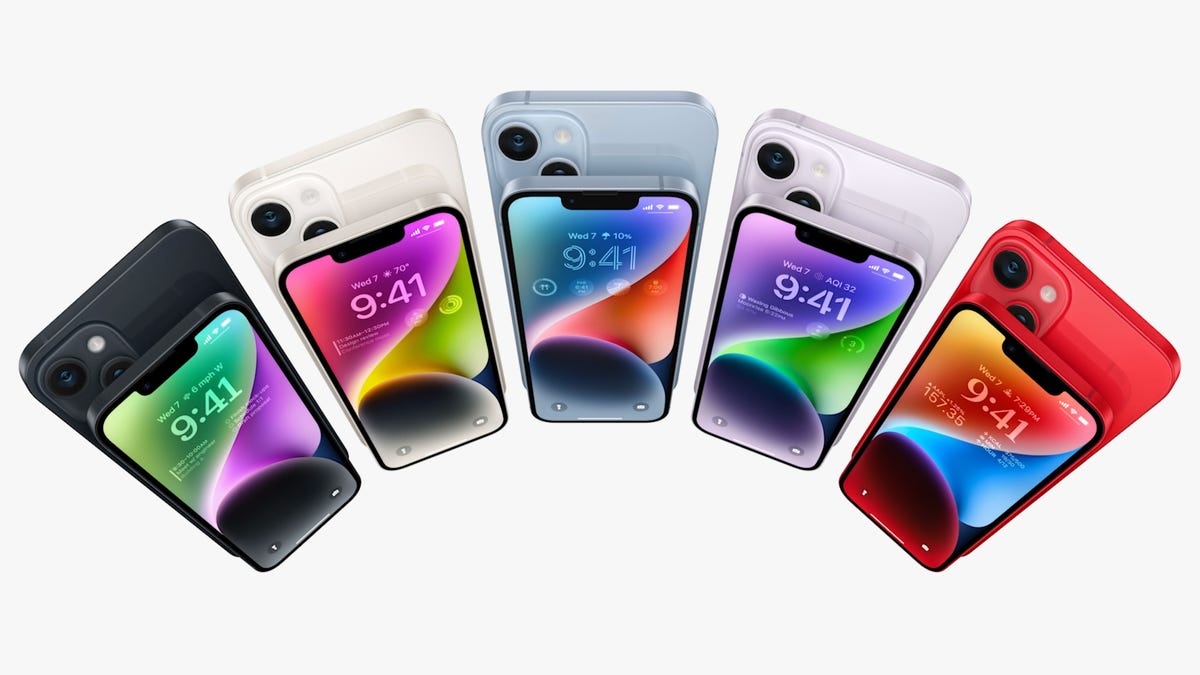

The iPhone 14 and iPhone 14 Plus
Apple
Not everything Apple showed off with the iPhone 14 aped prior Android ideas. The A16 Bionic chip on the iPhone 14 Pro is a beast of a mobile processor and will likely remain king in the smartphone world, unless Google upends it with the Pixel 7 later this year. The Super Retina XDR display offers a peak brightness of 2,000 nits, surpassing the Galaxy S22 Ultra at 1,750 nits. The Emergency SOS satellite service feature is something that’s reserved for chunky satellite phones, but gives iPhone 14 users a way to call for help if ever in a dangerous situation in remote US or Canada. And the TrueDepth front-facing camera will give selfies a more natural bokeh effect.
All that said, whenever a tech company flaunts its wares, it’s always good to have some degree of skepticism.
The post The iPhone 14’s Newest Features Have Been on Android for Years first appeared on Joggingvideo.com.
]]>The post Should You Upgrade to the iPhone 14? How It Compares to Older iPhones first appeared on Joggingvideo.com.
]]>This story is part of Focal Point iPhone 2022, CNET’s collection of news, tips and advice around Apple’s most popular product.
Apple’s new iPhone 14 lineup is now on sale, except for the iPhone 14 Plus, which arrives Oct. 7. With a new generation here, you might be wondering if it’s time to upgrade. The answer largely depends on which phone you currently have. If you have a recent model like the iPhone 13 or 12, you can afford to wait. If your phone is older though, it’s worth figuring out how much you’ll gain by jumping to a newer iPhone.
The $799 (£849, AU$1,399) iPhone 14 brings modest improvements that are appreciated but not game-changing, like nitty-gritty camera improvements, car-crash detection and the support for satellite-based emergency messaging. (Hopefully, you’ll never be in a situation where you’ll need to use the latter two).
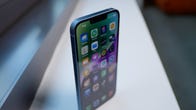

Now playing:
Watch this:
iPhone 14 Review: A Decent Upgrade for Most
9:53
The iPhone 14 Pro and Pro Max’s upgrades are more dramatic, but you still don’t need to upgrade unless you can score a great trade-in deal. Apple saved its most interesting new features for the Pro lineup, including the Dynamic Island that replaces the notch, the new A16 Bionic processor and a 48-megapixel main camera sensor. If you prefer larger phones, you may want to wait until Apple releases the iPhone 14 Plus before making your decision.
It’s important to remember that you don’t have to buy the iPhone 14 to get camera, battery and performance improvements over an earlier iPhone. The recently discounted $699 iPhone 13 or the smaller $599 13 Mini could be a good option if you still want more storage, faster performance and an improved camera, especially if you are coming from a phone that’s three years old or more. It’s also the only option if you want the smaller Mini and its 5.4-inch screen, since the iPhone 14 line eliminates that size in favor of the new $899 iPhone 14 Plus with a 6.7-inch screen.

Purchasing decisions will always vary depending on budget, how well your phone works right now and your personal needs, so there’s no simple answer that works for everyone. But here are the biggest differences between the iPhone 14 lineup and previous iPhone generations to help you make a decision.
Apple’s Newest Releases
- iPhone 14 Pro, Pro Max Review: Welcome to Apple’s Dynamic Island
- iPhone 14 Review: A Good Upgrade for Most People
- Apple Watch Series 8 Review: Improvement By Degrees
- Apple Watch SE Review: Almost Everything I Want
- Apple iOS 16 Released: New iPhone Features From the Update
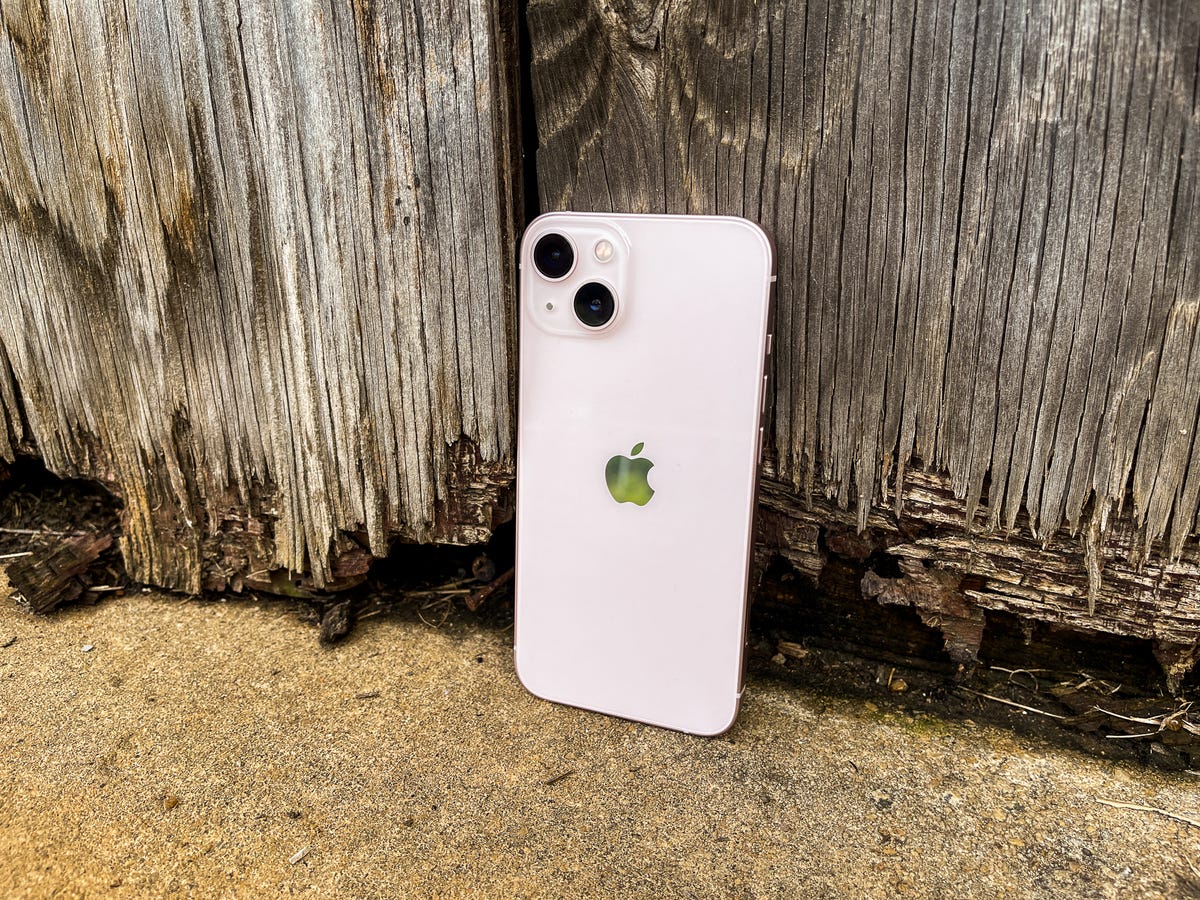

The iPhone 13.
Patrick Holland/CNET
iPhone 14 vs. iPhone 13, 13 Pro, 13 Pro Max
The iPhone 14 lineup introduces new features such as car-crash detection, the removal of the physical SIM card for US phones, and enhanced cameras on the rear and front. Despite those changes, iPhone 14 isn’t different enough to justify upgrading from the iPhone 13. And even though Apple finally got rid of the infamous notch in the Pro Models, the 14 and 14 Plus still have one — it’s the same smaller notch that debuted on the iPhone 13 series. In fact, the iPhone 14 represents “one of the most minimal year-over-year upgrades in Apple’s history,” according to CNET’s Patrick Holland, who reviewed Apple’s latest phones.
The iPhone 14 and iPhone 14 Plus have the A15 Bionic chip from last year’s iPhone 13 Pro and iPhone 13 Pro Max. The 14’s screen looks exactly like the one on the 13. Perhaps the most prominent change this year is the introduction of a larger version of the iPhone 14 called the iPhone 14 Plus, which has a 6.7-inch screen like the Pro Max. That means you no longer have to splurge on Apple’s most expensive iPhone if you want the largest screen possible.
Of course, the iPhone 14 is still highly rated, but we recommend saving your money and skipping the upgrade. If you’ve made up your mind to upgrade, we suggest going for an iPhone 14 Pro or iPhone 14 Pro Max if you can afford it. These phones are expensive, but buys you access to some salient changes — namely a high-refresh rate display, Apple’s new Dynamic Island multitasking bar, an always-on display as well as better cameras among other features.
The bottom line: If you have an iPhone 13 or 13 Pro, don’t upgrade. But if you are determined to get a new phone, go for the iPhone 14 Pro or 14 Pro Max, especially if you must have the Dynamic Island right now.
Read More: iPhone 14 Pro and 14 Pro Max Review
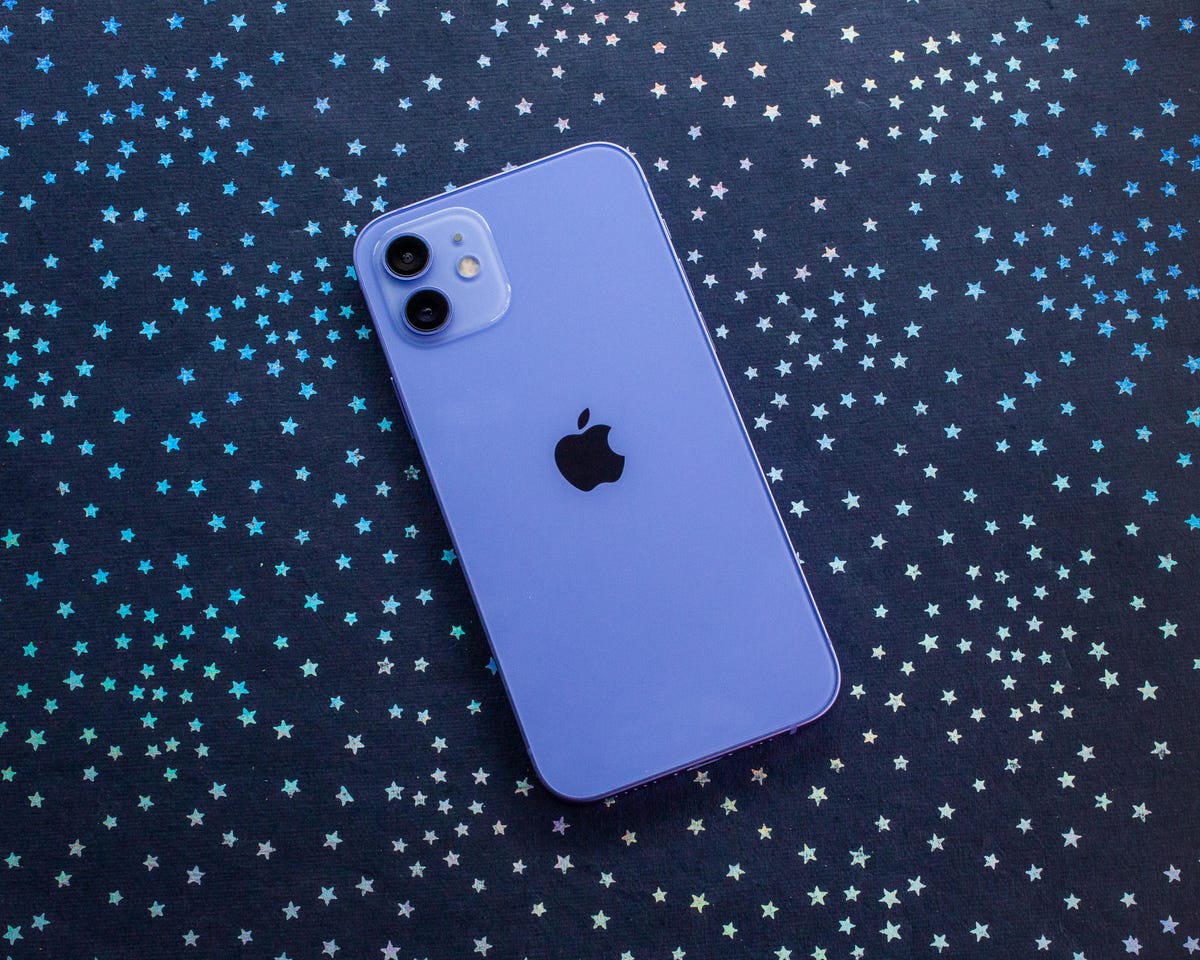

The iPhone 12.
Sarah Tew/CNET
iPhone 14 vs. iPhone 12, 12 Pro
Even though the iPhone 12 lineup was released two years ago, they still share many similarities with Apple’s latest phones. Both the iPhone 12 and iPhone 14 support 5G, run on fast processors, offer great cameras and include MagSafe accessory compatibility.
Since the iPhone 14 is more of a refresh than a major upgrade, we recommend hanging onto your iPhone 12 if it’s still in good condition. You can take advantage of the iPhone’s latest software features such as lock screen customizations, widgets and the ability to unsend text messages by upgrading to iOS 16.
The iPhone 14 received a few notable camera upgrades, like a larger sensor, a new lens with a faster aperture, improved photo processing and Action Mode which makes the movements in videos look smoother when you record them.
But the iPhone 12’s cameras remain excellent even though they are two years old. The iPhone 12 has a 12-megapixel dual camera system, while the iPhone 12 Pro includes a third camera with a telephoto lens. Check out our iPhone 12 review to see how the cameras held up when CNET put them through the paces.
It’s worth remembering that you get more noticeable upgrades with the iPhone 14 Pro and Pro Max. These include everything that’s new in the 14, as well as an upgraded main camera with a larger 48-megapixel sensor, an ultrawide camera that allows you to take Macro photos and a third camera with a telephoto lens. If you can get a good trade-in deal that significantly knocks down the iPhone 14 Pro’s price, upgrading from the regular iPhone 12 is a decent step-up.
The bottom line: Hold onto your iPhone 12 for another year since the iPhone 14 isn’t dramatically different. However, the iPhone 14 Pro and 14 Pro Max bring more significant changes that could be worthwhile if you can snag a good trade-in deal.
Read More: All The “New” iPhone Features That Have Been on Android For Years
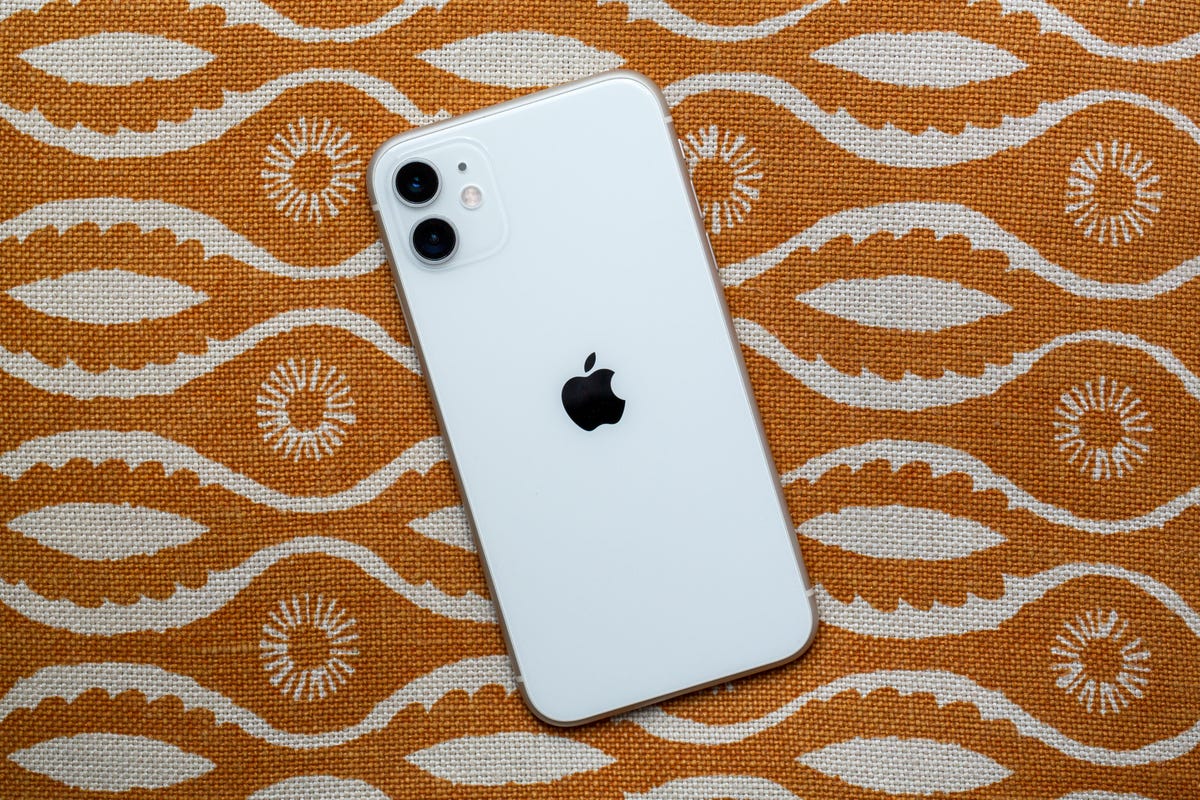

The iPhone 11.
Angela Lang/CNET
iPhone 14 vs. iPhone 11, 11 Pro
If you’re using an iPhone 11, we recommend upgrading to an iPhone 14 (or even an iPhone 13). In the last three years, Apple has made enough changes to features including battery life, performance, screen quality, cameras and durability to merit buying a new iPhone.
Upgrading to the iPhone 14 will get you 5G support, more storage (128GB at the base level versus 64GB) a better main camera with a wider aperture lens, new video shooting options like Action mode and Cinematic mode, a better selfie camera with Night mode and Apple’s Photonic Engine processing, compatibility with Apple’s MagSafe accessories, longer battery life and faster performance. That’s in addition to car-crash detection and Apple’s new emergency satellite messaging feature.
Most of the photography and videography improvements are dramatic changes compared to the iPhone 11. And the longer battery life and additional storage space are welcomed upgrades that you’ll notice on a daily basis.
As previously mentioned, if you go for the 14 Pro instead, you get a new 48-megapixel main camera, a closer 3x optical zoom versus the 11 Pro Max’s 2x zoom, the Dynamic Island instead of the notch and numerous other upgrades like an always-on display.
The bottom line: The iPhone 14 lineup includes enough changes to justify upgrading from the iPhone 11. But if your phone is still in good condition and you’re satisfied with it, install iOS 16 and hold onto it for another year.
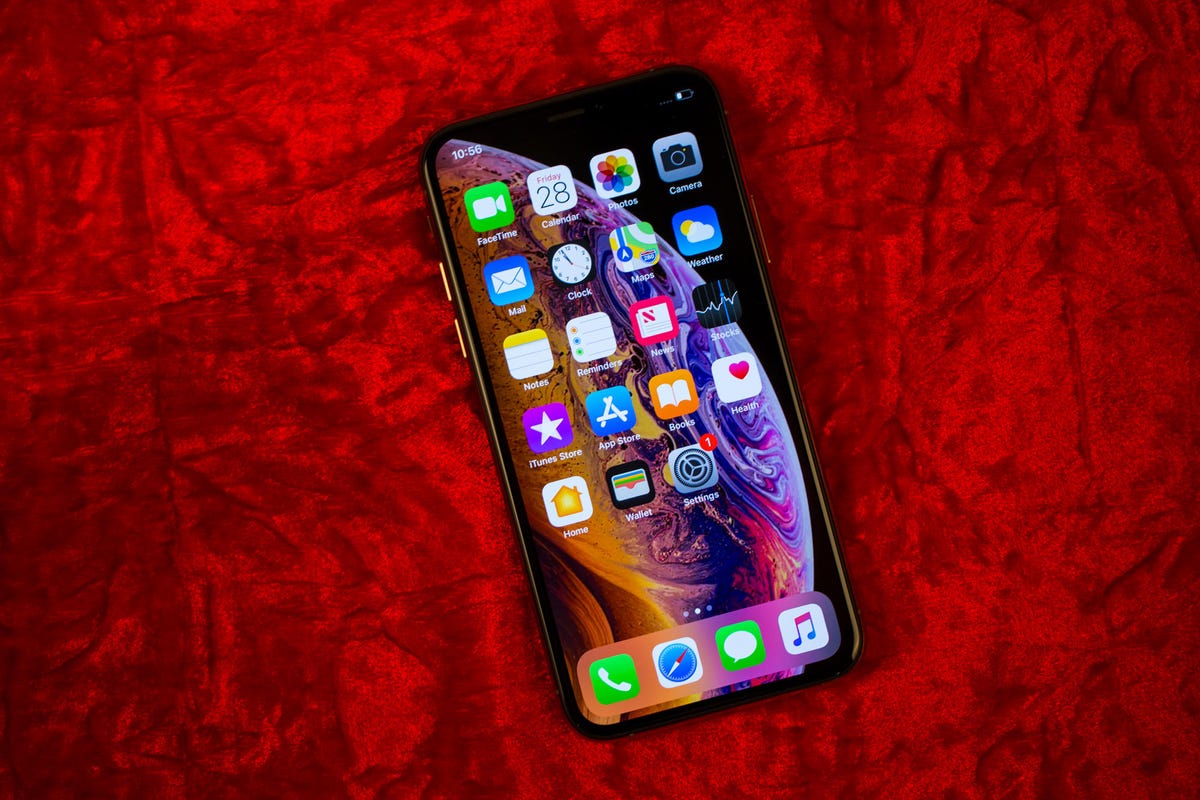

The iPhone XS
Josh Miller/CNET
iPhone 14 vs. iPhone XS, XS Max, XR
If you bought the iPhone XS, XS Max or XR at launch, that means your phone is roughly four years old and may be starting to feel sluggish. That alone makes a strong case for upgrading, but there’s plenty more to gain.
Compared to the iPhone XS, the iPhone 14 provides six hours of additional battery life (according to Apple’s estimates). In addition to everything that’s new in the iPhone 14 specifically, you’ll also get other upgrades Apple has added to the iPhone over the past few years.
Those include 5G support, more storage (again, you get 128GB versus 64GB), faster performance and a better camera. The iPhone XS generation lacks Night mode for taking clearer pictures in the dark, and it also doesn’t have Deep Fusion, which is Apple’s name for its image processing technique that improves detail and clarity in darker environments. The XS’s front camera has a lower 7-megapixel resolution compared to the larger and newer 12-megapixel sensor on the iPhone 14. If you’re upgrading from an iPhone XR, you’ll also get an additional camera with an ultrawide lens for taking broader group shots for the first time.
The iPhone 14 also has a larger 6.1-inch screen compared to the iPhone XS’ 5.8-inch display (the iPhone XS Max has a 6.5-inch screen, while the XR’s screen is also 6.1 inches). The design has also changed quite a bit over the past four years; newer models have flat edges, a slightly smaller notch, different finishes and a new “squircle”-shaped camera module that replaces the pill-shaped rear camera cutout. So your phone will not only feel more modern, but it’ll look newer, too.
The bottom line: If you have an iPhone XS, XS Max or XR, it’s definitely worth upgrading. You get a noticeable boost in camera quality, battery life and performance among other areas.
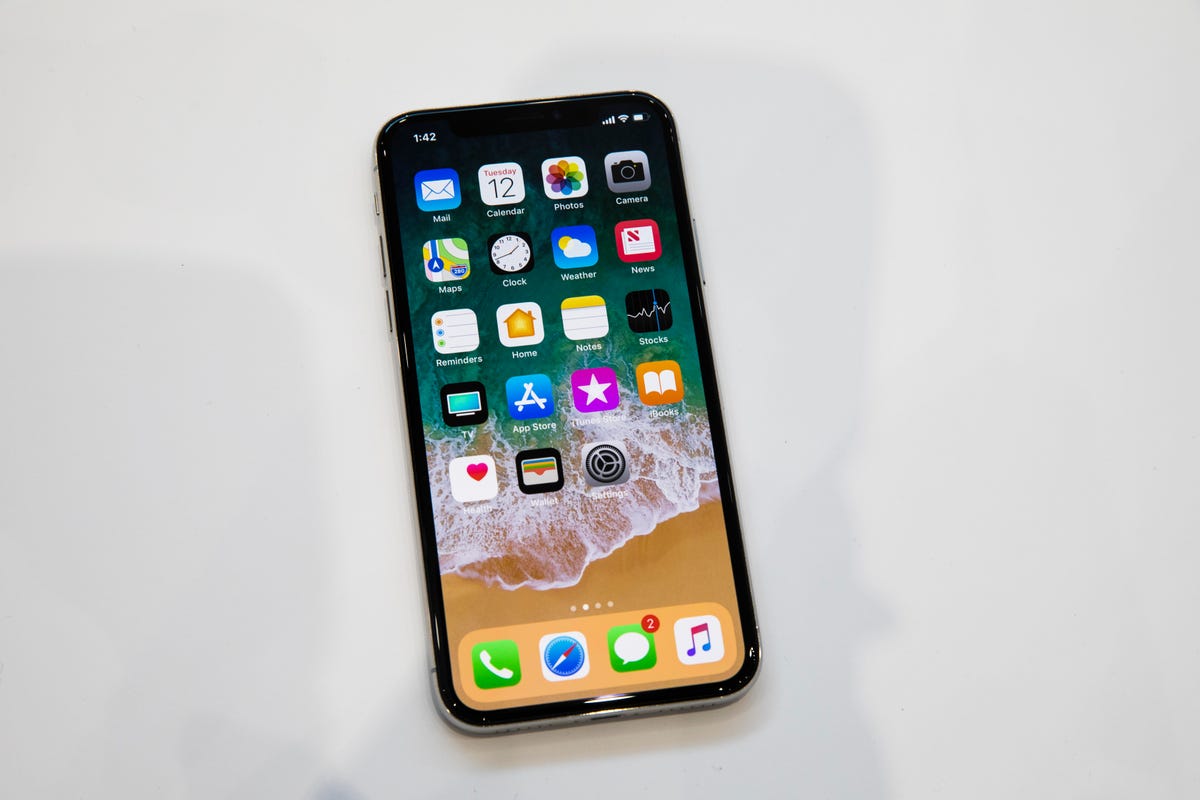

The iPhone X.
James Martin/CNET
iPhone 14 vs. iPhone X
The iPhone X is about five years old, which means it probably feels slow and its battery life isn’t what it used to be. With an iPhone 14, you’ll notice a major upgrade in both categories, as well as design, improved durability, connectivity and camera quality.
Let’s start with performance. The iPhone X runs on a much older A11 Bionic chip that’s now five years old, while the iPhone 14 runs on Apple’s A15 Bionic processor. The iPhone 14 Pro and Pro Max run on Apple’s newer A16 Bionic chip. Both new processors are way ahead of the A11 chip, which only has a two-core neural engine compared to the A15 Bionic’s 16-core neural engine.
The iPhone’s neural engine powers tasks that rely on machine learning and artificial intelligence, which are becoming a bigger part of the iPhone experience. Things like app suggestions in the App Library and Apple’s Translate app rely on machine learning to function, which indicates that the iPhone X may struggle to keep up with newer capabilities.
The iPhone X also has a dual-lens camera similar to that of the iPhone XS, meaning it’s missing the iPhone 14’s camera hardware improvements in addition to Night mode, Deep Fusion and the ability to control depth-of-field and blur levels in Portrait mode. Like the iPhone XS, you’re only getting a 7-megapixel front camera compared to a 12-megapixel selfie camera on Apple’s newer phones.
Apple’s five-year-old iPhone also has shorter battery life, with Apple estimating it should last for 13 hours when playing back video compared to 20 hours on the iPhone 14. The iPhone 14’s 6.1-inch screen is bigger than the 5.8-inch display on the iPhone X, and it should also be brighter since it can reach 800 nits of max brightness compared to the iPhone X’s 625-nit screen.
The iPhone 14 supports Dolby Atmos and spatial audio playback, while the iPhone X just has stereo playback. That’s probably not a deal-breaker, but might be crucial if you watch a lot of video on your phone without headphones.
And of course, there’s the benefit of getting car-crash detection, Apple’s new emergency SOS messaging via satellite option, better water resistance (up to 6 meters for 30 minutes versus 1 meter), 5G support, more storage space, Ceramic Shield for the display, a refreshed design and the option to use MagSafe accessories on the iPhone 14.
The bottom line: If you have the iPhone X, it’s time to upgrade. The iPhone 14 will feel new in just about every way, from the camera to performance, battery life and the way it looks and feels.
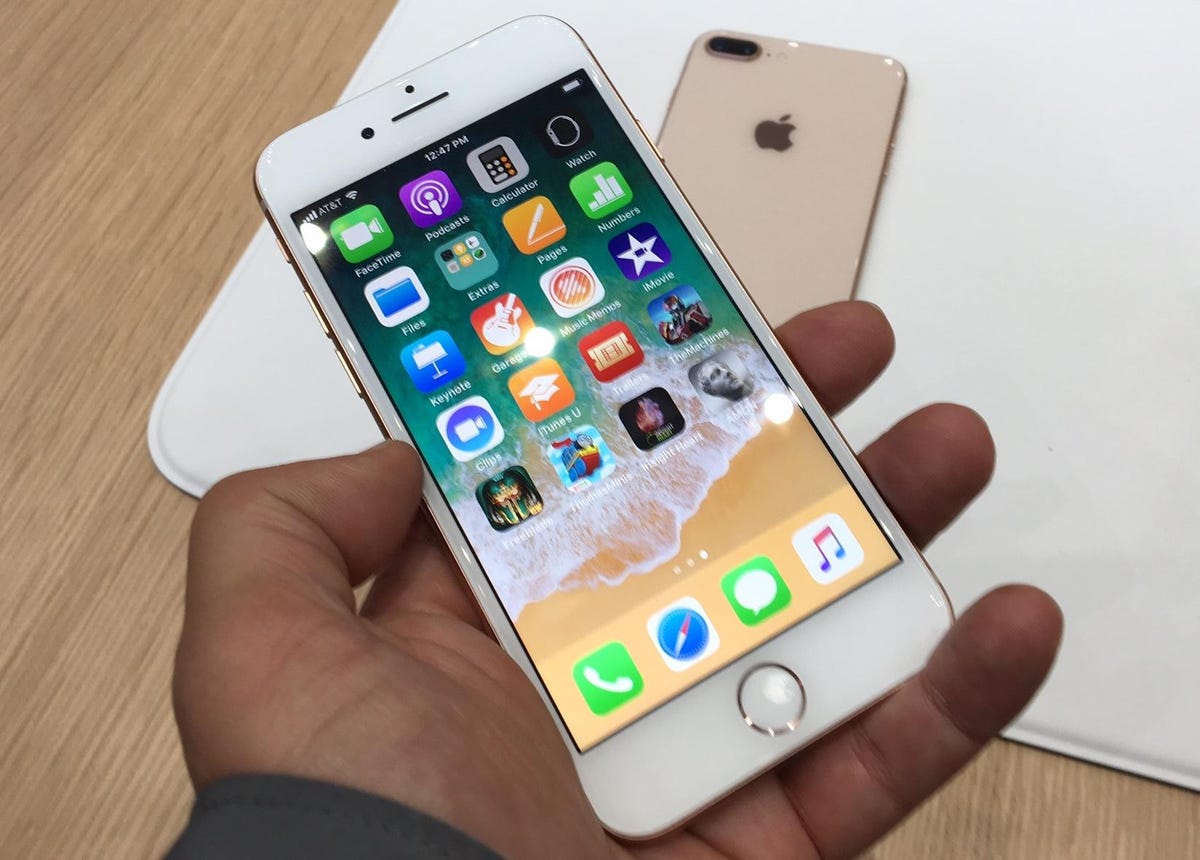

The iPhone 8 and 8 Plus.
Gabriel Sama/CNET
iPhone 13 vs. iPhone 8, 8 Plus
The iPhone 8 generation has Apple’s legacy iPhone design, which is fitting for a phone that’s now five years old. If you have an iPhone 8 and are considering an upgrade, many of the reasons to do that are the same as the reasons to upgrade from the iPhone X. The processor is getting old, which could make it harder to use newer iPhone features that rely on machine learning. The cameras are outdated and lack features like Night mode (the smaller iPhone 8 doesn’t have Portrait mode either, since it only has one lens). By upgrading, you’ll get more storage, significantly longer battery life, support for 5G connectivity and MagSafe accessories, too.
But the biggest difference is in the iPhone 8’s design, which is much more than just an aesthetic upgrade. Phones with Apple’s more modern edge-to-edge screen trade Touch ID for Face ID, which lets you unlock your phone and authenticate payments just by looking at your device. If you prefer Touch ID over Face ID, especially since it’s difficult to use Face ID while wearing a mask, you might want to at least consider upgrading to the $429 iPhone SE, since it has the same processor as the iPhone 13, 5G compatibility and plenty of photography improvements inside a similar body to the iPhone 8.
Upgrading to the iPhone 14 has a noticeably large jump in display size and quality. Since newer phones like the iPhone 14 don’t have a home button, there’s more room for Apple to expand the screen without making the device feel cumbersome. The iPhone 14’s screen is even larger than the iPhone 8 Plus’ 5.5-inch screen despite the device itself feeling more compact. (And for more perspective, consider that the iPhone 13 Mini has a 5.4-inch display). If you go for the 14 Pro you get another big change: the Dynamic Island, which transforms the notch area into an area for viewing alerts, system notifications and apps running in the background like Spotify or Apple Music.
From personal experience, switching from an iPhone 8 (which has a 4.7-inch screen) to the iPhone 12’s 6.1-inch display makes reading, checking email and watching videos much more comfortable. The screen isn’t only larger, but it’s also more vibrant with better contrast since it uses an OLED display rather than LCD.
The bottom line: The iPhone 14 is a huge jump from the iPhone 8. Everything about this phone will feel fast and new: the much larger and bolder screen, Face ID, the speedier processor, its longer battery life and of course the substantially upgraded cameras. Of note however, if you really want to get a newer iPhone but keep the iPhone 8’s design, trade up to the current 2022 iPhone SE.
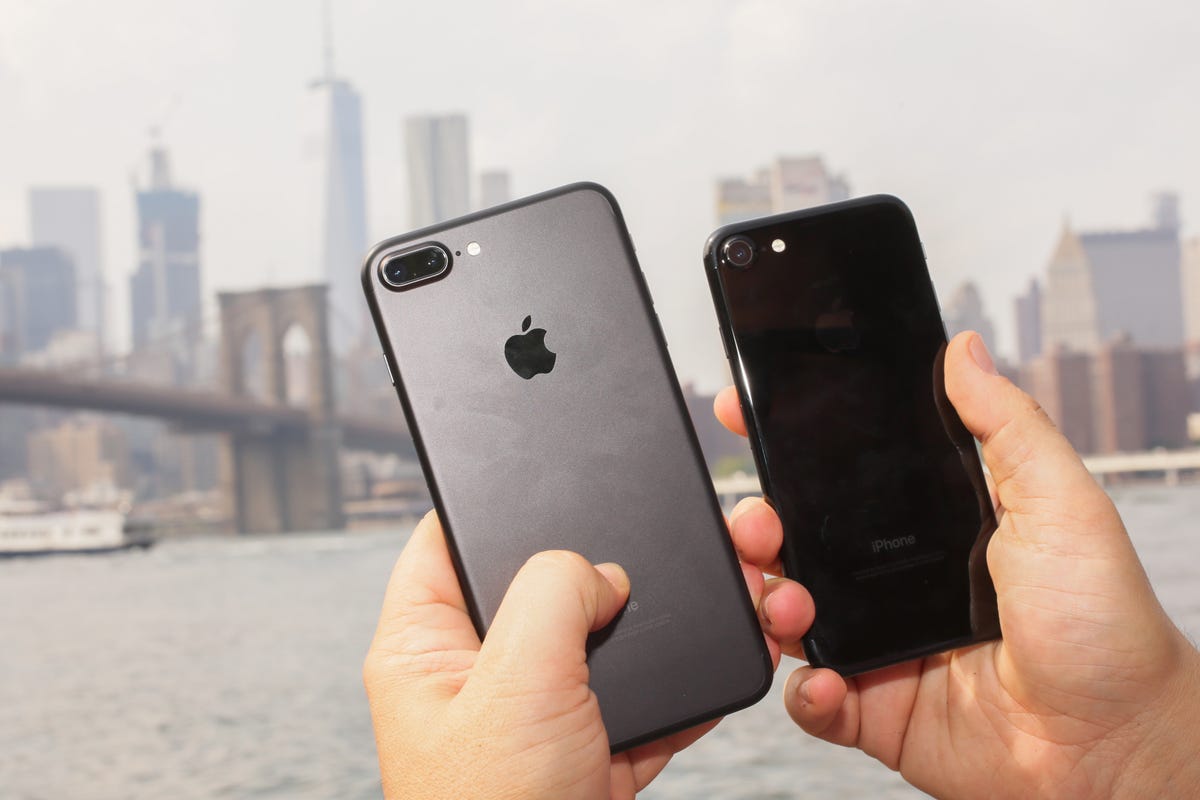

The iPhone 7 Plus and iPhone 7.
Sarah Tew/CNET
iPhone 13 vs. iPhone 7, 7 Plus
If you have an iPhone 7, it’s time to upgrade. It is six years old, and it shows in everything from the processor to the camera and storage space. The iPhone 7 doesn’t support iOS 16, providing even more incentive for acquiring a newer device.
While we generally recommend choosing the iPhone 14 Pro over the iPhone 14 in most cases, coming from a phone this old, means you’ll find plenty that’s new in the iPhone 14.
The iPhone 7 runs on an aging A10 Fusion processor, which doesn’t even have a neural engine and is several years behind Apple’s latest technology. It has a single-lens camera without Portrait mode, while the 7 Plus has two cameras. But those cameras lack many modern features like Night mode and Portrait Lighting, which adds specific lighting effects to your portraits.
Similar to the iPhone 8, the iPhone 7 series includes Touch ID and comes in either 4.7- or 5.5-inch screen sizes. But since the iPhone 7 is a year older than the iPhone 8, it’s also missing wireless charging, which means you must plug it in to charge.
If you’ve owned an iPhone 7 for several years, it’s probably bursting at the seams since it has substantially less storage space. The entry-level iPhone 7 only came with 32GB of space, which is a quarter of capacity available on the cheapest iPhone 14.
The iPhone 14 brings major gains in nearly every aspect. The standard model has a larger, bolder and brighter bezel-free 6.1-inch screen that still feels compact since it doesn’t have a home button. It runs on Apple’s A15 Bionic processor, which is better equipped to handle newer iOS features. And it has a drastically improved dual-lens camera with a larger main camera sensor and advanced features like the new Cinematic mode for video and Night mode. Plus, Apple’s estimates indicate it’ll offer seven hours of additional battery life during video playback, which is a huge bump.
The bottom line: If you’re still holding onto your iPhone 7, there’s no question that you’re due for an upgrade. A better screen, compatibility with iOS 16, longer battery life and more advanced cameras are just a few of the gains the iPhone 14 has to offer over the iPhone 7. And similar to my recommendation with the iPhone 8, if you really want to keep the home button and save some money, consider the iPhone SE. It gives you more recent performance upgrades while keeping a similar phone style.
The post Should You Upgrade to the iPhone 14? How It Compares to Older iPhones first appeared on Joggingvideo.com.
]]>